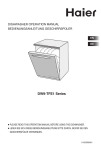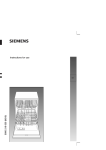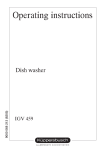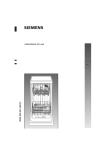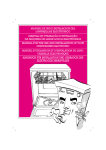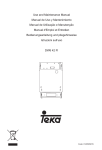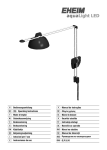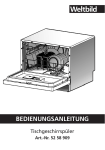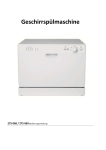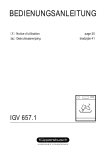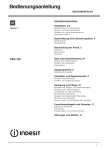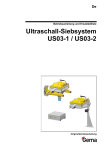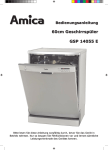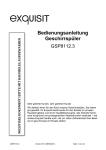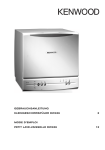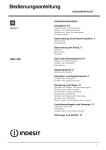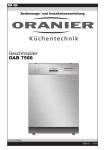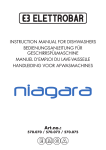Download IT Instruzioni su`ll uso DE Gebrauchsanweisung GB Instructions for
Transcript
a IT Instruzioni su'll uso DE Gebrauchsanweisung GB Instructions for Use Bosch Info-Team: nternet: http://www. bosch-hausgeraete.de it Indice Avvertenze di sicurezza . . . . Conoscere l’apparecchio . . . Impianto di addolcimento dell’acqua Riempimento con sale speciale Riempire il brillantante . . . . . . Stoviglie non idonee . . . . . . . Disposizione delle stoviglie . . Detersivo . . . . . . . . . . . . . . . . . Tabella programmi . . . . . . . . . de Lavaggio stoviglie . . . . . . . . . Funzioni supplementari * . . . Manutenzione e cura . . . . . . . Diagnosi dei guasti . . . . . . . . Per chiamare il servizio assistenza clienti . . . . . . . . . . Avvertenze . . . . . . . . . . . . . . . Installazione . . . . . . . . . . . . . . 16 18 19 21 27 28 29 30 31 32 33 35 Programmübersicht . . . . . . . . Geschirrspülen . . . . . . . . . . . . Zusatzfunktionen * . . . . . . . . . Wartung und Pflege . . . . . . . . Fehlersuche . . . . . . . . . . . . . . Kundendienst rufen . . . . . . . . Hinweise . . . . . . . . . . . . . . . . . Installation . . . . . . . . . . . . . . . . 38 39 41 42 44 46 47 48 50 51 52 53 54 55 Programme overview . . . . . . Washing dishes . . . . . . . . . . . Additional functions * . . . . . . . Care and maintenance . . . . . Fault finding . . . . . . . . . . . . . . Customer Service . . . . . . . . . Other information . . . . . . . . . . Installation . . . . . . . . . . . . . . . . 61 62 64 65 67 69 70 71 23 24 25 Inhaltsverzeichnis Sicherheitshinweise . . . . . . . . Gerät kennen lernen . . . . . . . Enthärtungsanlage . . . . . . . . Spezialsalz einfüllen . . . . . . . Klarspüler einfüllen . . . . . . . . Nicht geeignetes Geschirr . . Geschirr einordnen . . . . . . . . Reiniger . . . . . . . . . . . . . . . . . . en 4 5 6 7 8 9 10 12 15 Index Safety information . . . . . . . . . Getting to know your dishwasher Water softener . . . . . . . . . . . . Filling the special salt container Filling the rinse-aid container Not suitable for the dishwasher Arranging crockery, glasses, etc. in the dishwasher . . . . . . Detergents . . . . . . . . . . . . . . . 56 58 it Avvertenze di sicurezza Alla consegna Controllare subito la presenza di eventuali danni di trasporto all’imballaggio e alla lavastoviglie. Non mettete in funzione un apparecchio danneggiato, ma consultate il Vostro fornitore. Siete pregati di smaltire il materiale d’imballaggio secondo le norme. Nell’installazione Eseguire l’installazione e l’allacciamento secondo le istruzioni per l’installazione e il montaggio. Durante i lavori d’installazione la lavastoviglie non deve essere collegata alla rete elettrica. Assicurarsi che il sistema di collegamento a massa dell’impianto elettrico domestico sia installato a norma. Le condizioni del collegamento elettrico e le indicazioni sulla targhetta d’identificazione della lavastoviglie devono coincidere. Per il collegamento elettrico non usare mai una prolunga. Per assicurare la stabilità, installare gli apparecchi ad incasso inferiore o gli apparecchi integrabili solo sotto a piani di lavoro continui, avvitati ai mobili contigui. La spina di alimentazione deve restare accessibile dopo l’installazione dell’apparecchio. Per alcuni modelli: La scatola di plastica per l’attacco dell’acqua contiene una valvola elettrica. Nel tubo flessibile di alimentazione passano i cavi elettrici di collegamento. Non tagliare questo tubo, non immergere la scatola di plastica nell’acqua. 4 Attenzione: Se l’apparecchio non si trova in una nicchia ed è quindi accessibile su un lato, è necessario rivestire la parte della cerniera di porta per motivi di sicurezza (pericolo di lesioni). Le coperture sono disponibili come accessori speciali presso il rivenditore specializzato o il Servizio di Assistenza Tecnica. Nell’uso quotidiano Utilizzare la lavastoviglie solo per l’uso domestico e solo per lo scopo indicato: lavaggio di stoviglie domestiche. Non sedersi, né salire sulla porta aperta. L’apparecchio potrebbe ribaltarsi. L’acqua nella vasca di lavaggio non è potabile. Non introdurre solventi nella vasca di lavaggio. Vi è pericolo di esplosione. Durante lo svolgimento del programma, aprire la porta solo con precauzione. Vi è pericolo di fuoriuscita di spruzzi d’acqua. Bambini in casa Vietare ai bambini di giocare con la lavastoviglie, oppure di usarla. Tenere i bambini lontano da detersivi e brillantanti. Tenere i bambini lontano dalla lavastoviglie aperta, in essa possono esservi ancora residui di detersivo. Sicurezza bambino * * in alcuni modelli Fare riferimento ai disegni nella copertina. 40 Inserire la sicurezza bambino ( Apertura porta 2 ) 41 Aprire la porta con sicurezza bambino inserita it 42 Escludere la sicurezza bambino In caso di danni Le riparazioni e gli interventi devono essere eseguiti solo da personale specializzato. Per le riparazioni e gli interventi, separare l’apparecchio dalla rete elettrica. Sfilare la spina di alimentazione o escludere la sicurezza. Tirare la spina, non il cavo. Chiudere il rubinetto dell’acqua. Per la rottamazione Rendere subito inutilizzabili gli apparecchi fuori uso, per evitare così successivi infortuni. Estrarre la spina, tagliare il cavo di alimentazione e rendere inutilizzabile il dispositivo di chiusura della porta. Provvedere ad una corretta rottamazione dell’apparecchio. Conoscere l’apparecchio Le illustrazioni del pannello comandi e del vano interno dell’apparecchio si trovano sull’ultima pagina a risvolto della copertina. Prima d’iniziare la lettura, aprire questa pagina. Pannello comandi 1 2 3 4 5 6 7 8 9 10 11 Attenzione: Selettore programmi / Interruttore ACCESO/SPENTO Apertura porta Guida rapida programmi* Spia di stand-by Spia di svolgimento programma Spia di fine programma Spia aggiunta sale Pulsante AVVIO/ARRESTO Avvio fra ore* Spia aggiunta brillantante* Lavaggio cesto superiore* * in alcuni modelli I bambini possono rimanere imprigionati all’interno dell’apparecchiatura (pericolo di asfissia) o trovarsi in altre situazioni di pericolo. Quindi: staccare la spina elettrica e il filo di rete, mettendolo da parte. Rovinare la serratura della porta in modo che questa non possa più chiudersi. 5 it Vano interno dell’apparecchio 20 21 22 23 24 25 26 27 28 29 30 31 32 Cesto stoviglie superiore Cestello posate supplementare* per il cesto superiore Étagère* Braccio di lavaggio superiore Braccio di lavaggio inferiore Contenitore per sale speciale Filtri Cestello posate Cesto stoviglie inferiore Dispositivo di chiusura Contenitore per brillantante con spia di aggiunta Contenitore detersivo Targhetta d’identificazione Impianto di addolcimento dell’acqua Per ottenere buoni risultati di lavaggio, la lavastoviglie richiede acqua dolce, cioè povera di calcare, altrimenti sulle stoviglie e sulle pareti interne si depositano residui di calcare bianchi. Per il buon funzionamento della lavastoviglie, l’acqua di rubinetto che superi un determinato grado di durezza deve essere addolcita, cioè decalcificata. Ciò avviene usando un sale speciale nell’impianto di addolcimento della lavastoviglie. La regolazione e con ciò la quantità di sale necessaria dipende dal grado di durezza dell’acqua di rubinetto disponibile. * in alcuni modelli Regolazione dell’impianto di addolcimento Acquistare per il primo uso: (Si vedano le istruzioni brevi) – sale – detersivo – brillantante Utilizzare esclusivamente prodotti adatti alla lavastoviglie. 6 it Riempimento con sale speciale Effetto del sale Durante il lavaggio, il sale viene diluito automaticamente dal contenitore del sale nell’addolcitore e qui scioglie il calcare. La soluzione contenente calcare viene pompata fuori dalla lavastoviglie. Il sistema di addolcimento dell’acqua è in seguito di nuovo pronto a ricevere. Questo procedimento rigenerativo funziona solo se il sale è disciolto nell’acqua. Aprire il tappo a vite del contenitore del sale 25 . Prima del primo uso, versare nel contenitore del sale ca. 1 litro d’acqua. Inserire l’accluso imbuto nella bocchetta di riempimento. Aggiungere poi sale, finché il contenitore del sale è pieno (max 1,5 kg). Quando si aggiunge il sale l’acqua trabocca. Infine pulire i dintorni della bocchetta di riempimento dai resti di sale e richiudere il contenitore, avvitando correttamente il tappo senza angolarlo. La spia livello del sale 7 nel pannello s’illumina all’inizio e si spegne dopo qualche minuto, quando è stata raggiunta una concentrazione di sale sufficiente. Con il valore d’impostazione ’0’ il sale non è necessario, poiché durante il funzionamento non viene consumato sale. Con i valori d’impostazione da ’1’ a ’3’ il sale è necessario. Attenzione Non introdurre mai detersivo nel contenitore per sale speciale. Così facendo distruggete l’impianto di decalcificazione. Spia livello sale É necessario riempire il sale non appena nel pannello s’illumina la spia livello sale 7 . 7 it Riempire il brillantante Il brillantante viene usato nel risciacquo, per ottenere bicchieri brillanti e stoviglie senza macchie. Aprire il coperchio del contenitore del brillantante 30 . A tale scopo premere sul riferimento sul coperchio del brillantante e contemporaneamente sollevare il coperchio con la linguetta di apertura . Regolare la quantità di erogazione brillantante É possibile la regolazione continua della quantità di erogazione del brillantante. Il regolatore di erogazione è stato disposto in fabbrica su 4. Cambiare la posizione del regolatore brillantante solo se sulle stoviglie si notano striature (girare in senso –), oppure macchie d’acqua (girare in senso +). 30 Versare il brillantante nella bocchetta di riempimento finché l’indicatore di livello si oscura. Chiudere il coperchio fino ad udire lo scatto d’arresto. Regolatore brillantante Spia livello brillantante Finché la spia di livello del brillantante nel pannello 10 (in alcuni modelli) o sul contenitore di erogazione 30 è oscura, il brillantante è ancora sufficiente. Avvertenza Usare solo brillantante per lavastoviglie domestiche. 8 Spia livello brillantante it Stoviglie non idonee Nella lavastoviglie non dovreste lavare: posate e stoviglie di legno. Esse lisciviano e assumono un brutto aspetto; inoltre i collanti usati per il legno non resistono alle temperature raggiunte. Oggetti di vetro decorati e vasi sensibili, specialmente stoviglie antiche o irrecuperabili. Quelle decorazioni non erano ancora resistenti al lavaggio in lavastoviglie. Non idonei sono inoltre anche pezzi in materiale plastico sensibile all’acqua calda, stoviglie in rame ed in stagno. Le decorazioni su vetro, i pezzi in alluminio e argento durante il lavaggio possono tendere a cambiare colore ed sbiancare. Anche alcuni tipi di vetro dopo molti lavaggi possono diventare opachi. Inoltre non introdurre nella lavastoviglie materiali assorbenti, come spugne e panni. Raccomandazione: in futuro acquistare solo stoviglie per le quali venga confermata l’idoneità al lavaggio in lavastoviglie. Danni a bicchieri e stoviglie Cause: Tipo di bicchieri e metodo di produzione dei bicchieri. Composizione chimica del detersivo. Temperatura dell’acqua e duranta del programma della lavastoviglie. Raccomandazione: usare bicchieri e porcellana indicati dal produttore come resistenti al lavaggio in lavastoviglie. Usare un detersivo indicato come delicato per le stoviglie. Informarsi presso il produttore del detersivo. Selezionare un programma con la minore temperatura possibile e la più breve durata di programma possibile. Al fine di evitare danni, dopo il termine del programma togliere al più presto vetri e posate dalla lavastoviglie. Avvertenza Nella lavastoviglie non devono essere lavate stoviglie sporcate con cenere, cera, grasso lubrificante o colori. 9 it 20 nb urg L e bu rg e L en u Lym ph en b Rimuovere i residui di cibo più grossi. Non è necessario sciacquare sotto acqua corrente. Disporre le stoviglie in modo che tutti i recipienti, come tazze, bicchieri, pentole ecc. abbiano l’apertura rivolta in basso, i pezzi con bombature o cavità siano obliqui, per consentire all’acqua di scolare, le stoviglie siano ben ferme e non possano ribaltarsi, non possano ostacolare la rotazione dei bracci di lavaggio durante il funzionamento. Si consiglia di non lavare le stoviglie molto piccole nella macchina, in quanto possono cadere facilmente dai cestelli. Per l’utilizzazione della funzione «Lavaggio cesto superiore» (solo in alcuni modelli) caricate solo il cesto superiore, il cesto inferiore deve essere vuoto. Cesto stoviglie superiore ym ph Sistemare le stoviglie Tazze e bicchieri ym ph Disposizione delle stoviglie Pentole Cesto stoviglie inferiore 28 Rimozione delle stoviglie Per evitare che le stoviglie del cestello superiore sgocciolino su quelle del cestello più in basso, si consiglia di svuotare dapprima il cestello inferiore e successivamente quello superiore. Posate Le posate dovrebbero essere disposte sempre alla rinfusa, con il manico rivolto in basso (attenzione a non ferirsi con le lame dei coltelli). In questa posizione il getto d’acqua raggiunge meglio i singoli pezzi. Per evitare il pericolo di ferite, disporre i pezzi lunghi ed acuminati ed i coltelli sull’étagère (in alcuni modelli), oppure sull’étagère per coltelli (disponibile come 10 it accessorio). Étagère per coltelli * Divisore ribaltabile * * in alcuni modelli * in alcuni modelli I divisori sono ribaltabili, per una migliore sistemazione di pentole e scodelle. Testa di spruzzo per lamiere da forno * * in alcuni modelli Fare riferimento ai disegni nella copertina. Le lamiere, oppure le griglie di grandi dimensioni possono essere lavate utilizzando la testa di spruzzo per lamiere da forno. A tal fine rimuovere il cesto superiore e inserire la testa di spruzzo come illustrato nel disegno. Affinché il getto polverizzato possa raggiungere tutti i pezzi, è opportuno disporre le lamiere come nella figura (max. 4 teglie da forno e 2 griglie). L’étagère * * per alcuni modelli Appoggiare i bicchieri alti ed i bicchieri a gambo lungo non contro le stoviglie, ma all’orlo dell’étagère, I pezzi lunghi, posate di servizio e per insalata, mestoli o coltelli, vanno sistemati sull’étagère, per non impedire la rotazione del braccio di lavaggio. L’étagère può essere abbassata o alzata a discrezione. 11 it Spostamento dei cesti* * per alcuni modelli Avvertenza per il detersivo Ø max. 20/*25cm 86cm 81cm Ø max. 20/*25cm Ø max. 30/*25cm Detersivo Ø max. 34/*29cm Il cesto superiore, se necessario, può essere usato sulle rotelle superiori, oppure sulle rotelle inferiori, per ottenere più spazio per le stoviglie più alte nel cesto superiore o inferiore. Nella lavastoviglie possono essere usati detersivi commerciali di marca liquidi, in polvere oppure detersivi in compresse per lavastoviglie (non usare detersivi per il lavaggio a mano !). Attualmente sul mercato sono disponibili tre tipi di detersivi: 1. contenenti fosforo e cloro 2. contenenti fosfati e senza cloro 3. senza fosfati e senza cloro Nell’uso di detersivi senza fosfati, se l’acqua è dura possono formarsi più facilmente depositi bianchi sulle stoviglie e sulle pareti interne della lavastoviglie. Tali residui possono essere evitati aggiungendo una maggiore quantità di detersivo. I detersivi senza cloro hanno un minore effetto di candeggio. Conseguenza di ciò possono essere maggiori residui di tè o alterazioni di colore sulle parti in materiale plastico. In tal caso i rimedi sono: – l’uso di un programma di lavaggio più energico, oppure – l’aggiunta di una maggiore quantità di detersivo, oppure – l’uso di detersivi cloroattivi. Sulla confezione del detersivo è indicato se il detersivo è idoneo per il lavaggio di stoviglie d’argento. Per altri quesiti, consigliamo di rivolgersi all’ufficio consulenza della casa produttrice del detersivo. 12 it Contenitore del detersivo con indice di dosaggio L’indice di dosaggio nel contenitore del detersivo è utile per versare la quantità giusta. Il contenitore contiene 15 ml di detersivo entro la linea inferiore e 25 ml entro la linea mediana. Nel contenitore pieno entrano 40 ml. 40 ml 25 ml 15 ml Avvertenza Se il contenitore del detersivo dovesse essere ancora chiuso, per aprirlo azionare il dispositivo di chiusura. Riempire il detersivo Versare il detersivo nel contenitore 31 . Per il dosaggio corretto, osservare le avvertenze della casa produttrice sulla confezione del detersivo. Per il programma «Intensivo», versare inoltre 10–15 ml di detersivo sulla porta dell’apparecchio. Consiglio per il risparmio Nel lavaggio del cesto superiore, oppure se le stoviglie sono poco sporche, di solito è sufficiente una quantità di detersivo inferiore alla quantità indicata. Chiudere il coperchio del contenitore detersivo. A tale scopo (1) spingere il coperchio del contenitore ed infine (2) premere leggermente su di esso fino a sentire lo scatto d’arresto. Se si usa detersivo in compresse, leggere sulla confezione dove devono essere collocate le compresse (p. es. cestello delle posate, contenitore del detersivo, ecc.). Badare che, anche se si usano compresse, il coperchio del contenitore del detersivo sia chiuso. 13 it ATTENZIONE ! – AVVERTENZA IMPORTANTE PER L’USO DI DETERGENTI COMBINATI GENTILE CLIENTE Le seguenti avvertenze devono essere rispettate quando si usano i cosiddetti detergenti combinati, i quali rendono necessario l’impiego ad esempio di brillantante o di sale: Alcuni prodotti contenenti brillantante possono avere un’efficacia ottimale soltanto qualora si utilizzino determinati programmi. Nel caso di apparecchi con programmi automatici, questo tipo di prodotti spesso non consente di ottenere il risultato desiderato. I prodotti che rendono superfluo l’impiego di sale di rigenerazione possono esser impiegati esclusivamente in combinazione con un ben determinato ambito di durezza dell’acqua. Qualora si desideri utilizzare questi prodotti ad azione combinata, si raccomanda di leggere attentamente le istruzioni per l’uso relative ai prodotti e le avvertenze eventualmente presenti sull’imballaggio! In caso di dubbio rivolgersi al produttore di detergenti, in particolare se: Le stoviglie sono ancora bagnate una volta concluso il programma. Si formano depositi calcarei. In caso di reclami legati direttamente all’impiego di questi prodotti, non verrà fornita alcuna prestazione di garanzia! 14 it Tabella programmi In questo sommario è rappresentato il massimo numero di programmi possibile. I corrispondenti programmi del vostro apparecchio risultano dal vostro pannello comandi. Tipo di stoviglie p. es. porcellana, resistenti pentole, posate, bicchieri ecc. Tipo di resti minestre, soufflé, di cibo sughi, patate, miste pasta, riso, uova, arrosti Quantità di resti di cibo molti Adesione dei resti di cibo forte Programma di lavaggio delicate minestre, patate, pasta, riso, uova, arrosti miste sciacquare le stoviglie sotto acqua corrente se restano molti giorni in pochissimi lavastoviglie prima del lavaggio. caffè, dolce, latte, salsicce, bevande fredde, insalate pochi debole Intensivo 70° / 75°* Normale 65° Prelavaggio 50° Prelavaggio Lavaggio 70° Lavaggio 65° Lavaggio 50° Lavaggio 40° Lavaggio 35° Risciacquo intermedio Risciacquo intermedio Risciacquo intermedio Risciacquo intermedio Risciacquo intermedio Risciacquo intermedio Risciacquo intermedio Ciclo finale di risciacquo 70° Ciclo finale di risciacquo 70° Ciclo finale di risciacquo 65° Ciclo finale di risciacquo 55° Ciclo finale di risciacquo 55° Asciugatura Asciugatura Asciugatura Asciugatura Eco 50° Delicato 40° Rapido 35° Prelavaggio * solo per Italia Svolgimento del programma Prelavaggio Prelavaggio Selezione del programma Secondo il tipo di stoviglie e la quantità e lo stato dei residui di cibo, nella tabella programmi potete trovare un’indicazione precisa del programma necessario. Consiglio per il risparmio Se la macchina è poco carica, spesso è sufficiente il successivo programma meno energico. 15 it Dati del programma Trovate i dati del programma nella guida rapida. Essi si riferiscono a condizioni normali. A causa di: diversa quantità di stoviglie temperatura di afflusso dell’acqua pressione della conduttura idraulica temperatura ambiente tolleranze della tensione di rete e tolleranze dipendenti dalla macchina (per es. temperatura, quantità d’acqua,...) si possono verificare differenze maggiori. I valori di consumo dell’acqua sono riferiti al valore di regolazione della durezza dell’acqua 2. Lavaggio stoviglie Accendere l’apparecchio e selezionare il programma Aprire completamente il rubinetto dell’acqua. Ruotare il selettore programmi 1 sul programma desiderato. Con ciò l’apparecchio è acceso, la spia di stand-by 4 si accende. Ora potete avviare il programma. Avviare il programma Premere il pulsante AVVIO/ARRESTO 8 . La spia di stand-by 4 si spegne, la spia di svolgimento programma 5 si accende. Il programma è in corso. Fine del programma Il programma è terminato quando la spia di svolgimento programma 5 si spegne e la spia di fine programma 6 si accende. Con la fine del programma viene eventualmente disattivata la funzione «Lavaggio cesto superiore» (solo in alcuni modelli). Alcuni minuti dopo la fine del programma: Aprire la porta dell’apparecchio. Estrarre le stoviglie dopo il raffreddamento. Dopo la fine del programma potete spegnere l’apparecchio oppure avviarlo di nuovo con lo stesso o con un altro programma. Spegnere l’apparecchio Alcuni minuti dopo la fine del programma, ruotare il selettore programmi 1 in posizione SPENTO. Chiudere il rubinetto dell’acqua (con Aquastop non è necessario). 16 it Interrompere il programma Premere il pulsante AVVIO/ARRESTO 8 . La spia di svolgimento programma 5 lampeggia, cioè il programma è interrotto. Ora potete aprire la porta dell’apparecchio, per es. per sistemare altre stoviglie. Non appena la porta è di nuovo chiusa, il programma prosegue automaticamente. In caso di collegamento ad acqua calda, oppure se l’apparecchio ha già eseguito il riscaldamento, prima di chiudere la porta, accostatela per qualche minuto, altrimenti la porta può aprirsi improvvisamente a causa dell’espansione dell’aria. Se non avete aperto la porta, per continuare il programma premete il pulsante AVVIO/ARRESTO 8 . Il programma può essere interrotto a porta chiusa per massimo 9 ore. Dopo questo tempo riprende automaticamente. Annullare il programma Premere per ca. 3 secondi il pulsante AVVIO/ARRESTO 8 . La spia di svolgimento programma 5 si spegne. Il programma è annullato, eventualmente viene disattivata anche la funzione «Lavaggio cesto superiore» oppure «Avvio fra ore» (solo in alcuni modelli). La spia di fine programma 6 lampeggia per ca. 1 minuto, contemporaneamente la pompa scarica l’acqua. Per non interrompere l’operazione della pompa, mentre la spia lampeggia dovreste lasciare invariate tutte le regolazioni e tenere la porta chiusa. Dopo che la pompa ha scaricato l’acqua, la spia di fine programma 6 si spegne e la spia di stand-by 4 si accende. Ora potete riavviare oppure spegnere l’apparecchio. Cambiare programma In qualsiasi momento potete cambiare programma (tranne che nella fase di programma ’Asciugatura’) semplicemente ruotando il selettore programmi 1 . Le fasi di programma già iniziate (per es. ’Lavaggio’) del programma precedente vengono portate a termine prima di proseguire nel nuovo programma con le fasi successive. Se è stata attivata una preselezione dell’ora d’avvio (solo in alcuni modelli), il conteggio a ritroso del tempo prosegue invariato. 17 it Funzioni supplementari * * in alcuni modelli Lavaggio cesto superiore* Usate questa funzione quando avete da lavare solo poche stoviglie. Con essa risparmiate energia ed acqua. Caricate solo il cesto superiore, il cesto inferiore deve essere vuoto. Introducete un poco di detersivo in meno di quanto consigliato per un carico completo della macchina. Selezionate un programma e, premendo il pulsante 11 , attivate il «Lavaggio cesto superiore», la relativa spia si accende. Il «Lavaggio cesto superiore» si disattiva premendo di nuovo il pulsante 11 oppure dopo ’Terminare/Annullare’ per un programma. Il «Lavaggio cesto superiore» può essere attivato e disattivato in qualsiasi momento, anche quando un programma è in corso. Avvio fra ore* Potete rinviare l’avvio del programma di 3 o di 9 ore. Selezionate un programma. Premete il pulsante «Avvio fra ore» 9 una volta (3 ore) o due volte (9 ore). Pochi secondi dopo la regolazione oppure dopo avere premuto il pulsante AVVIO/ARRESTO 8 inizia il conteggio a ritroso del tempo, la relativa spia del tempo è accesa fino all’inizio del programma. Dopo 6 ore, la spia di 9 si spegne e la spia di 3 ore si accende. Trascorso il tempo selezionato, il programma viene avviato automaticamente. Per interrompere il conteggio a ritroso del tempo, premete il pulsante AVVIO/ARRESTO 8 . Premendo di nuovo questo pulsante, il conteggio a ritroso del tempo continua. L’apertura della porta dell’apparecchio non interrompe il conteggio a ritroso del tempo. Per cancellare la preselezione dell’ora d’avvio premete più volte il pulsante «Avvio fra ore» 9 finché tutte le spie del tempo sono spente. Il programma selezionato inizia dopo pochi secondi. Avvertenza Se durante il funzionamento l’alimentazione elettrica dell’apparecchio viene interrotta per es. spegnendolo oppure a causa d’interruzione di corrente, tutte le regolazioni eseguite si conservano. Il funzionamento riprende automaticamente non appena l’alimentazione elettrica è stata ripristinata. 18 it Manutenzione e cura Il controllo e la manutenzione regolari alla macchina contribuiscono ad prevenire guasti. Ciò comporta un risparmio di noie e di tempo. Perciò ogni tanto dovreste guardare attentamente l’interno della Vostra lavastoviglie. Stato generale della macchina Controllare se nella vasca di lavaggio vi sono depositi di grasso e calcare. Se si riscontrano simili depositi: Lavare accuratamente la macchina con detersivo. Sale speciale Controllare la spia livello sale necessario riempire il sale. 7 . Se Brillantante Controllare la spia livello brillantante nel pannello 10 , oppure il livello del liquido nel contenitore 30 . Se necessario aggiungere brillantante. Per il montaggio: collocare il sistema di filtri ed avvitarlo con il filtro cilindrico. Filtri I filtri 26 impediscono alle impurità grosse nell’acqua di lavaggio di raggiungere la pompa. Queste impurità talvolta possono otturare i filtri. Il sistema di filtri è costituito da un filtro cilindrico, da un filtro fine piatto e, secondo il tipo di apparecchio, da un microfiltro aggiuntivo (*). Dopo ogni lavaggio, controllare se i filtri trattengono residui. Svitando il filtro cilindrico si può estrarre il sistema di filtri. Rimuovere i resti e lavare i filtri sotto acqua corrente. 19 it Pompa di scarico dell’acqua Bracci di lavaggio Calcare e impurità nell’acqua di lavaggio possono bloccare gli ugelli e i supporti dei bracci di lavaggio 23 e 24 . Torx T20 1 2 Controllare se gli ugelli di uscita dei bracci di lavaggio sono otturati da residui di cibo. Eventualmente estrarre verso l’alto il braccio inferiore 24 . Svitare il braccio superiore 23 . Pulire i bracci di lavaggio sotto acqua corrente. Innestare o avvitare di nuovo i bracci di lavaggio. I resti di cibo grossi nell’acqua di lavaggio, che non siano stati trattenuti dai filtri, possono bloccare la pompa di scarico dell’acqua. L’acqua di lavaggio in tal caso non viene scaricata dalla pompa e si ferma sul filtro. Perciò: event. vuotare tutta l’acqua, smontare i filtri, 26 . svitare la vite dal coperchio (Torx T 20) e rimuovere il coperchio, controllare se all’interno vi sono corpi estranei, ed eventualmente rimuoverli, rimettere ed avvitare il coperchio, rimettere ed avvitare i filtri. 3 2 1 0 Bracci di lavaggio 20 it Diagnosi dei guasti Eliminare da soli piccoli guasti Secondo l’esperienza, la maggior parte dei disturbi, che si verificano nell’uso quotidiano, possono essere eliminati da Voi stessi, senza necessità di rivolgersi al servizio assistenza clienti. Con ciò si risparmiano naturalmente costi e si assicura rapidamente la disponibilità della macchina. Il seguente sommario si propone di aiutarvi a trovare le cause dei degli eventuali disturbi. Disturbo ... all’accensione L’apparecchio non si avvia Fusibile domestico guasto. Spina dell’apparecchio non infilata. Porta dell’apparecchio non chiusa correttamente. Rubinetto dell’acqua non aperto. Filtro otturato nel tubo flessibile di alimentazione dell’ acqua. Il filtro si trova nel raccordo dell’Aquastop oppure del tubo flessibile di alimentazione. ... nell’apparecchio Il braccio di lavaggio inferiore non gira liberamente Il braccio di lavaggio è bloccato da parti minute o da residui di cibo. Il coperchio del detersivo non si chiude Contenitore del detersivo troppo pieno Meccanismo bloccato da residui di detersivo aderenti. Dopo il lavaggio le spie non si spengono. Il selettore programmi 1 non è in posizione SPENTO. Residui di detersivo dopo il lavaggio aderiscono nel contenitore del detersivo Al riempimento il contenitore era umido, versare il detersivo solo nel contenitore asciutto. Alla fine del programma l’acqua resta nell’apparecchio. Il tubo flessibile di scarico è otturato o piegato. La pompa di scarico dell’acqua è bloccata. I filtri sono otturati. Il programma non è ancora terminato. Attendere la fine del programma (la spia di fine programma 6 si accende). Attivare la funzione «Annullare il programma». ... e nel lavaggio Attenzione Tenere presente: le riparazioni devono esser eseguite solo da personale specializzato. Da riparazioni inappropriate possono derivare danni considerevoli e pericoli per l’utilizzatore. Insolita formazione di schiuma Detersivo per lavaggio a mano nel contenitore di brillantante. Il brillantante versato può causare un’eccessiva formazione di schiuma durante la successiva operazione di lavaggio. Si consiglia pertanto di rimuovere con un panno il brillantante fuoriuscito. 21 it La spia di svolgimento programma 5 lampeggia ed il programma non procede Il programma è stato interrotto. Proseguire il programma premendo il pulsante AVVIO/ ARRESTO 8 . La porta dell’apparecchio è aperta. Richiudere la porta. Il selettore programmi è stato ruotato su una posizione, che non corrisponde ad un programma. Ruotare il selettore programmi di nuovo sul programma desiderato. L’apparecchio si ferma durante il lavaggio Alimentazione elettrica interrotta. Alimentazione dell’acqua interrotta. Rumore battente durante il lavaggio Il braccio di lavaggio urta contro stoviglie. Rumore di acciottolìo durante il lavaggio Stoviglie non disposte correttamente. Rumore battente delle valvole di riempimento Dipende dall’installazione della tubazione dell’acqua e non ha conseguenze sul funzionamento della macchina. Impossibile rimediare. 22 ... sulle stoviglie Residui di cibo restano attaccati alle stoviglie Le stoviglie sono state disposte male, i getti d’acqua non hanno potuto colpire la superficie. Il cesto era troppo pieno. Le stoviglie sono disposte l’una a contatto con l’altra. É stato messo troppo poco detersivo. É stato selezionato un programma di lavaggio troppo debole. Qualche stoviglia impediva la rotazione del braccio di lavaggio. Gli ugelli del braccio di lavaggio sono otturati da residui di cibo. I filtri sono otturati. I filtri sono inseriti male. La pompa di scarico dell’acqua è bloccata. Alterazione di colore sui pezzi in materiale plastico É stato riempito troppo poco detersivo. Il detersivo ha un effetto candeggiante troppo ridotto. Sostituire il detersivo con candeggiante al cloro. Macchie bianche restano in parte sulle stoviglie, i bicchieri restano opachi É stato riempito troppo poco detersivo. É stata impostata una quantità di brillantante troppo ridotta. Nonostante l’alta durezza dell’acqua, non è stato riempito sale speciale. Impianto di addolcimento regolato troppo basso. Il coperchio del contenitore del sale non è ben stretto. Se è stato usato un detersivo senza fosfati, usare per un confronto un detersivo con fosfati. it Le stoviglie non si asciugano É stato selezionato un programma senza asciugatura. É stata regolata una quantità di brillantante troppo ridotta. Stoviglie sgombrate troppo presto. Aspetto non brillante dei bicchieri Quantità di brillantante regolata troppo bassa. Le tracce di tè o di rossetto non sono state eliminate completamente Il detersivo ha un effetto sbiancante troppo debole. É stata selezionata una temperatura di lavaggio troppo bassa. Tracce di ossido sulle posate Posate non abbastanza inossidabili. Contenuto di sale troppo alto nell’acqua di lavaggio. Coperchio del contenitore del sale non stretto bene. Nel riempire il sale è stato versato troppo sale nella vasca. I bicchieri perdono trasparenza e cambiano colore, la patina si stacca con difficoltà É stato riempito il detersivo non idoneo. I bicchieri non sono resistenti al lavaggio in lavastoviglie. Su bicchieri e posate restano striature, i bicchieri acquistano un aspetto metallico Quantità di brillantante regolata troppo alta. Per chiamare il servizio assistenza clienti Se non riuscite ad eliminare il disturbo, site pregati di rivolgervi al servizio assistenza clienti. Il più vicino centro di assistenza risulta dall’elenco del servizio assistenza clienti. Alla chiamata indicate il numero di apparecchio (1) e il numero FD (2), che trovate sulla targhetta d’identificazione sulla porta dell’apparecchio. 1 FD 2 Attenzione L’intervento del personale tecnico del Servizio di Assistenza reso necessario da un utilizzo non corretto o dall’insorgere di una delle anomalie descritte non sarà gratuito neppure durante il periodo di validità della garanzia. 23 it Avvertenze Avvertenze per lo smaltimento Gli apparecchi dismessi non sono rifiuti senza valore! Attraverso lo smaltimento ecologico possono essere recuperati materiali pregiati. Al fine della sicurezza si prega di tagliare il cordone di alimentazione elettrica dell’apparecchio dismesso. Distruggere il dispositivo di chiusura della porta. S’impedisce in questo modo che bambini possano imprigionarsi per gioco e rischiare la vita. L’imballaggio ha protetto il Vostro nuovo apparecchio nel trasporto fino a Voi. Tutti i materiali utilizzati sono compatibili con l’ambiente e riciclabili. Siete pregati di collaborare, con uno smaltimento ecologico dell’imballaggio. L’imballaggio e le sue parti non sono un giocattolo, perciò evitare che i bambini lo usino per il gioco. Pericolo di soffocamento a causa di scatole ripiegabili e fogli di plastica. Informarsi presso il proprio rifornitore o la propria amministrazione comunale sulle attuali vie di smaltimento. 24 Avvertenze per prove comparative Le condizioni per le prove comparative si trovano sulla scheda supplementare ”Avvertenze per le prove comparative”. I valori di consumo relativi ai vari programmi sono illustrati nelle istruzioni brevi. Generali Gli apparecchi ad incasso inferiore e integrati, che in un secondo tempo vengono installati come apparecchi standard, devono essere bloccati contro il ribaltamento, p. es. mediante avvitatura alla parete, oppure montaggio sotto un piano di lavoro continuo, avvitato ai mobili contigui. Solo per la versione per la Svizzera: l’apparecchio può essere senz’altro montato tra pareti di legno o di plastica, in una serie di mobili da cucina. Se l’apparecchio non viene allacciato per mezzo di una spina, per soddisfare le pertinenti norme di sicurezza, nell’impianto domestico deve essere disponibile un dispositivo di separazione onnipolare, con un’apertura tra i contatti di almeno 3 mm. it Installazione Per un funzionamento regolare, la lavastoviglie deve essere collegata a regola d’arte. I dati di alimentazione e scarico ed altresì i valori di allacciamento elettrico devono corrispondere ai criteri richiesti, indicati nei capitoli seguenti o nelle istruzioni di montaggio. Nel montaggio, osservare il seguente ordine di passi di lavoro: – controllo alla consegna, – installazione, – allacciamento dello scarico dell’acqua, – allacciamento dell’alimentazione dell’acqua, – allacciamento elettrico. Consegna La lavastoviglie è stata controllata accuratamente in fabbrica, per accertare il suo perfetto funzionamento. A causa di ciò sono rimaste piccole macchie d’acqua. Queste scompaiono al primo ciclo di risciacquo. Allacciamento dell’alimentazione acqua Collegare il tubo dell’alimentazione acqua al rubinetto dell’acqua secondo le istruzioni per il montaggio, servendosi delle parti a corredo. Fare attenzione che il tubo di allacciamento per l’alimentazione dell’acqua non sia piegato, schiacciato o avvolto su se stesso. Alla sostituzione dell’apparecchio, per l’allacciamento al rubinetto dell’acqua è sempre necessario utilizzare un nuovo tubo di alimentazione dell’acqua. È vietato usare il vecchio tubo di alimentazione. Pressione dell’acqua: minimo 0,5 bar, massimo 10 bar. In caso di pressione dell’acqua superiore: collegare a monte una valvola di riduzione della pressione. Quantità di alimentazione: minimo 10 litri/minuto. Temperatura dell’acqua: preferibile acqua fredda; con acqua calda, temper. max. 600C. Installazione Allacciamento elettrico Le misure di montaggio necessarie risultano dalle istruzioni per il montaggio. Installare l’apparecchio orizzontale utilizzando i piedi regolabili. Ciò facendo badare alla stabilità. Collegare l’apparecchio solo a corrente alternata a 230 V, tramite una presa con collegamento a massa installata a norma. Protezione necessaria, vedi targhetta d’identificazione 32 . La presa deve essere installata in prossimità della lavastoviglie ed essere liberamente accessibile. Le modifiche all’allacciamento devono essere eseguite solo da un elettricista. Se è necessario prolungare il cavo di allacciamento, non tagliare la spina. L’intero cavo può essere sostituito mediante collegamento nella scatola di connessione dietro all’apparecchio. In caso d’impiego di un interruttore di sicurezza per correnti di guasto, è consentito solo l’impiego di un tipo d’interruttore con il simbolo . Solo questo interruttore automatico garantisce il rispetto delle norme vigenti. Allacciamento dello scarico acqua Per le operazioni di lavoro necessarie, consultare le istruzioni per il montaggio, montare eventualmente un sifone con manicotto di scarico. Collegare il tubo di scarico al manicotto di scarico del sifone servendosi delle parti a corredo. Fare attenzione che il tubo flessibile di scarico non sia piegato, schiacciato o avvolto su se stesso. (Attenzione, nessun tappo di chiusura deve impedire il deflusso dell’acqua sporca!) 25 it Smontaggio Sicurezza antigelo Anche per questo è importante l’ordine delle operazioni: separare assolutamente innanzitutto l’apparecchio dalla rete elettrica. Sfilare la spina di alimentazione. Chiudere il rubinetto dell’acqua. Staccare l’alimentazione e lo scarico dell’acqua. Svitare le viti di fissaggio sotto al piano di lavoro. Se disponibile, smontare il pannello dello zoccolo. Estrarre l’apparecchio e tirare con precauzione il tubo flessibile. Se l’apparecchio è collocato in un locale esposto a pericolo di gelo (p. es. casa vacanze), deve essere svuotato completamente (vedi trasporto). Chiudere il rubinetto dell’acqua, staccare il tubo flessibile di alimentazione e farlo svuotare. Trasporto Vuotare la lavastoviglie. Fissare le parti mobili. Trasportare l’apparecchio solo verticale. Se l’apparecchio non viene trasportato verticale, l’acqua residua può raggiungere il comando di macchina e provocare così errori nello svolgimento del programma. L’apparecchio deve essere vuotato compiendo le operazioni seguenti: Aprire il rubinetto dell’acqua. Selezionare un programma qualsiasi, avviarlo e lasciarlo in funzione per ca. 4 minuti. Interrompere il programma premendo per 3 secondi il pulsante AVVIO/ARRESTO 8 . La spia di fine programma 6 lampeggia.. Attendere finché dopo ca. 1 minuto la spia di fine programma 6 non si spegne e la Spia di stand-by 4 non si accende. Ruotare il selettore programmi in posizione SPENTO. Chiudere il rubinetto dell’acqua. 26 de Sicherheitshinweise Bei der Anlieferung Überprüfen Sie Verpackung und Geschirrspüler sofort auf Transportschäden. Nehmen Sie ein beschädigtes Gerät nicht in Betrieb, sondern nehmen Sie Rücksprache mit Ihrem Lieferanten. Entsorgen Sie das Verpackungsmaterial bitte ordnungsgemäß. Bei der Installation Nehmen Sie Aufstellung und Anschluss nach der Installations– und Montageanweisung vor. Bei der Installation muss der Geschirrspüler vom Netz getrennt sein. Stellen Sie sicher, dass das Schutzleitersystem der elektrischen Hausinstallation vorschriftsmäßig installiert ist. Elektrische Anschlussbedingungen und Angaben auf dem Typenschild des Geschirrspülers müssen übereinstimmen. Benutzen Sie zum Anschluss niemals Verlängerungskabel. Bauen Sie Unterbau– oder integrierbare Geräte nur unter durchgehenden Arbeitsplatten ein, die mit den Nachbarschränken verschraubt sind, um die Standsicherheit zu gewährleisten. Nach dem Aufstellen des Gerätes muss der Stecker frei zugänglich sein. Bei einigen Modellen: Das Kunststoffgehäuse am Wasseranschluss enthält ein elektrisches Ventil, im Zulaufschlauch befinden sich die Anschlussleitungen. Schneiden Sie diesen Schlauch nicht durch, tauchen Sie das Kunststoffgehäuse nicht in Wasser. Warnung: Wenn das Gerät nicht in einer Nische steht und damit eine Seitenwand zugänglich ist, muss der Türscharnierbereich aus Sicherheitsgründen seitlich verkleidet werden (Verletzungsgefahr). Die Abdeckungen erhalten Sie als Sonderzubehör beim Kundendienst oder im Fachhandel. Im täglichen Betrieb Benutzen Sie den Geschirrspüler nur im Haushalt und nur zum angegebenen Zweck: Dem Spülen von Haushaltsgeschirr. Setzen oder stellen Sie sich nicht auf die geöffnete Tür. Das Gerät könnte kippen. Das Wasser im Spülraum ist kein Trinkwasser. Geben Sie kein Lösungsmittel in den Spülraum. Es besteht Explosionsgefahr. Die Tür während des Programmablaufs nur vorsichtig öffnen. Es besteht die Gefahr, dass Wasser aus dem Gerät spritzt. Bei Kindern im Haushalt Erlauben Sie Kleinkindern nicht, mit dem Geschirrspüler zu spielen oder ihn zu bedienen. Halten Sie Kleinkinder vom Reiniger und Klarspüler fern. Halten Sie Kleinkinder vom geöffneten Geschirrspüler fern, es könnten sich noch Reste vom Reiniger darin befinden. 27 de Kindersicherung * * bei einigen Modellen Beachten Sie hierzu die Zeichnungen hinten im Umschlag. 40 Kindersicherung einschalten ( Türöffner 2 ) 41 Tür öffnen mit eingeschalteter Kindersicherung 42 Kindersicherung ausschalten Bei auftretenden Schäden Reparaturen und Eingriffe dürfen nur durch den Fachmann ausgeführt werden. Bei Reparaturen und Eingriffen muss das Gerät vom Netz getrennt sein. Netzstecker ziehen oder Sicherung ausschalten. Am Netzstecker ziehen, nicht am Anschlusskabel. Wasserhahn zudrehen. Bei der Entsorgung Machen Sie ausgediente Geräte sofort unbrauchbar, um spätere Unfälle damit auszuschließen. Führen Sie das Gerät einer ordnungsgemäßen Entsorgung zu. Warnung: Kinder könnten sich im Gerät einsperren (Erstickungsgefahr) oder in andere Gefahren Situationen geraten. Deshalb: Netzstecker ziehen, Netzkabel durchtrennen und beseitigen. Türschloss so weit zerstören, dass die Tür nicht mehr schließt. 28 Gerät kennen lernen Die Abbildungen der Bedienblende und des Geräteinnenraumes befinden sich hinten im Umschlag. Schlagen Sie bitte vor dem Lesen diese Seite auf. Bedienblende 1 2 3 4 5 6 7 8 9 10 11 Programmwähler / EIN–/AUS–Schalter Türöffner Programmübersicht* Betriebsbereitschafts–Anzeige Programmablauf–Anzeige Programmende–Anzeige Salznachfüllanzeige START–/STOP–Taste Zeitvorwahl * Klarspülernachfüllanzeige * Oberkorbspülen * * bei einigen Modellen de Geräteinnenraum 20 21 22 23 24 25 26 27 28 29 30 31 32 Oberer Geschirrkorb Zusätzlicher Besteckkorb * für den Oberkorb Etagere * Oberer Sprüharm Unterer Sprüharm Vorratsbehälter für Spezialsalz Siebe Besteckkorb Unterer Geschirrkorb Verschlussriegel Vorratsbehälter für Klarspüler mit Nachfüllanzeige Reinigerkammer Typenschild * bei einigen Modellen Enthärtungsanlage Für gute Spülergebnisse benötigt der Geschirrspüler weiches, d.h. kalkarmes Wasser, ansonsten lagern sich weiße Kalkrückstände auf Geschirr und Innenbehälter ab. Leitungswasser oberhalb eines bestimmten Wasserhärtegrades muss für den Betrieb im Geschirrspüler enthärtet, d.h. entkalkt werden. Dies geschieht mit Hilfe von Spezialsalz in der Enthärtungsanlage des Geschirrspülers. Die Einstellung und damit die benötigte Salzmenge ist abhängig vom Härtegrad Ihres Leitungswassers. Enthärtungsanlage einstellen (siehe Kurzanleitung) Zum Erstbetrieb einkaufen: – Spezialsalz – Reiniger – Klarspüler Verwenden Sie ausschließlich Produkte, die für Geschirrspüler geeignet sind. 29 de Spezialsalz einfüllen Wirkungsweise des Salzes Während des Spülens wird automatisch das Salz aus dem Salzbehälter in den Enthärter geschwemmt und löst dort den Kalk. Die kalkhaltige Lösung wird aus dem Geschirrspüler gepumpt. Das Enthärtungssystem ist danach wieder aufnahmebereit. Dieser Regenerierungsablauf funktioniert nur dann, wenn das Salz im Wasser gelöst ist. Öffnen Sie den Schraubverschluss des Vorratsbehälters 25 . Vor der ersten Inbetriebnahme müssen Sie in den Salzbehälter ca. 1 Liter Wasser gießen. Setzen Sie den beigelegten Trichter in die Einfüllöffnung ein. Füllen Sie dann so viel Salz nach, bis der Salzbehälter voll ist (max. 1,5 kg). Wenn Sie Salz einfüllen, wird Wasser verdrängt und läuft ab. Das Salznachfüllen muß deshalb immer unmittelbar vor dem Einschalten des Geschirrspülers erfolgen. Dadurch erreichen Sie, dass die überlaufende Salzlösung sofort verdünnt und ausgespült wird. Säubern Sie anschließend den Einfüllbereich von Salzresten und schrauben Sie den Behälter zu, ohne den Deckel zu verkanten. Die Salznachfüllanzeige 7 in der Blende leuchtet zunächst und erlischt erst nach einiger Zeit, wenn sich eine genügend hohe Salzkonzentration gebildet hat. Bei dem Einstellwert ’0’ muss kein Salz eingefüllt werden, weil im Betrieb auch kein Salz verbraucht wird, die Salznachfüllanzeige 7 in der Bedienblende ist nicht in Funktion. Bei den Einstellwerten ’1’ bis ’3’ muss Salz eingefüllt werden. Warnung Füllen Sie niemals Reiniger in den Spezialsalzbehälter. Sie zerstören damit die Enthärtungsanlage. Salznachfüllanzeige Salz ist nachzufüllen, sobald die Salznachfüllanzeige 7 in der Blende leuchtet. 30 de Klarspüler einfüllen Klarspüler wird im Spülbetrieb verbraucht, um klare Gläser und fleckenloses Geschirr zu erhalten. Deckel des Vorratsbehälters für Klarspüler 30 aufklappen. Drücken Sie hierzu auf die Markierung auf dem Klarspülerdeckel und heben Sie den Deckel gleichzeitig an der Bedienlasche an. Zugabemenge für Klarspüler einstellen Die Klarspülerzugabemenge ist stufenlos einstellbar. Der Klarspülerregler ist vom Werk auf 4 gestellt. Ändern Sie die Stellung des Klarspülerreglers nur, wenn Schlieren (Drehen in Richtung – ) oder Wasserflecken (Drehen in Richtung + ) auf dem Geschirr zurückbleiben. 30 Klarspüler in die Einfüllöffnung einfüllen bis die Füllstandsanzeige dunkel wird. Deckel schließen bis er hörbar einrastet. Klarspülerregler Klarspülernachfüllanzeige Solange die Klarspülernachfüllanzeige in der Blende 10 (nur bei einigen Modellen) oder am Vorratsbehälter 30 dunkel erscheint, ist genügend Klarspüler vorhanden. Hinweis Verwenden Sie nur Klarspüler für Haushaltsgeschirrspüler. Klarspülernachfüllanzeige 31 de Nicht geeignetes Geschirr Nicht in Ihrem Geschirrspüler reinigen sollten Sie: Besteck– und Geschirrteile aus Holz. Sie laugen aus und werden unansehnlich; auch sind die verwendeten Kleber nicht für die auftretenden Temperaturen geeignet. Empfindliche Dekorgläser und Vasen, spezielles antikes oder unwiederbringliches Geschirr. Diese Dekore waren noch nicht spülmaschinenfest. Nicht geeignet sind außerdem heißwasserempfindliche Kunststoffteile, Kupfer– und Zinngeschirr. Aufglasdekore, Aluminium– und Silberteile können beim Spülen zum Verfärben und Verblassen neigen. Auch einige Glassorten können nach vielen Spülgängen trüb werden. Weiter gehören sich voll saugende Materialien, wie Schwämme und Tücher, nicht in den Geschirrspüler. Empfehlung: Kaufen Sie künftig nur Geschirr, dass als spülmaschinenfest gekennzeichnet ist. Hinweis Geschirrteile, die mit Asche, Wachs, Schmierfett oder Farbe verunreinigt sind, dürfen nicht in den Geschirrspüler. 32 Glas– und Geschirrschäden Ursachen: Glasart und Glasherstellungsverfahren. chemische Zusammensetzung des Reinigers. Wassertemperatur und Programmdauer der Geschirrspülmaschine. Empfehlung: Gläser und Porzellan verwenden, das vom Hersteller als spülmaschinenfest bezeichnet wird. Reiniger verwenden, der als geschirrschonend gekennzeichnet ist, bei Reinigerherstellern nachfragen. Programm mit möglichst geringer Temperatur und kurzer Programmdauer wählen. Um Beschädigungen zu vermeiden, Glas und Besteck nach Programmende möglichst bald aus dem Geschirrspüler entnehmen. de Geschirr einordnen Geschirr einräumen Grobe Speisereste entfernen. Vorspülen unter fließendem Wasser ist nicht nötig. Geschirr so einräumen, dass alle Gefäße, wie Tassen, Gläser, Töpfe usw. mit der Öffnung nach unten stehen. Teile mit Wölbungen oder Vertiefungen schräg stehen, damit das Wasser ablaufen kann. es sicher steht und nicht kippen kann. es die Drehung der beiden Sprüharme im Betrieb nicht behindert. Sehr kleine Geschirrteile sollten nicht in der Maschine gespült werden, da sie leicht aus den Körben fallen können. Bei Verwendung der Funktion ’Oberkorbspülen’ (nur bei einigen Modellen) beladen Sie nur den Oberkorb, der Unterkorb muss leer sein. Töpfe Unterer Geschirrkorb 28 Besteck Um zu vermeiden, dass Wassertropfen vom oberen Korb auf das Geschirr im unteren Korb fallen, ist es empfehlenswert, zuerst den unteren und dann den oberen Korb zu entleeren. Bestecke sollten Sie immer unsortiert mit der Essfläche nach oben einordnen (Vorsicht mit Messerklingen). Der Sprühstrahl erreicht so die einzelnen Teile besser. Um Verletzungsgefahr zu vermeiden, legen Sie lange und spitze Teile und Messer auf die Etagere (bei einigen Modellen) oder auf die Messeretagere (als Zubehör erhältlich). Tassen und Gläser Klappstacheln * Oberer Geschirrkorb * bei einigen Modellen Die Stacheln sind umklappbar, zum besseren Einordnen von Töpfen und Schüsseln. Geschirr ausräumen 20 ym ph L e nb urg ym ph rg e L en bu u ph Lym en b 33 de Backblechsprühkopf * Etagere * * bei einigen Modellen Beachten Sie hierzu die Zeichnungen hinten im Umschlag. Große Bleche oder Gitter können Sie mit Hilfe des Backblechsprühkopfes reinigen. Entnehmen Sie hierzu den Oberkorb und setzen Sie den Sprühkopf wie in der Zeichnung dargestellt ein. Damit der Sprühstrahl alle Teile erreichen kann, ordnen Sie die Bleche bitte wie abgebildet ein (max. 4 Backbleche und 2 Gitter). * bei einigen Modellen Langstielige und hohe Gläser am Rand der Etagere (nicht gegen Geschirr) anlehnen. Messeretagere * * bei einigen Modellen Lange Teile, Vorlege– und Salatbestecke, Kochlöffel oder Messer finden auf der Etagere Platz, damit sie die Sprüharmumdrehung nicht behindern. Die Etagere können Sie nach Belieben ein– und ausschwenken. 34 de Korbhöhe verstellen * * bei einigen Modellen Hinweis zum Reiniger Ø max. 20/*25cm 86cm 81cm Ø max. 20/*25cm Ø max. 30/*25cm Reiniger Ø max. 34/*29cm Der obere Geschirrkorb kann nach Bedarf auf den oberen Rollen oder den unteren Rollen benutzt werden, um entweder im Ober– oder Unterkorb mehr Platz für höhere Geschirrteile zu erhalten. In Ihrem Geschirrspüler können Sie die im Handel befindlichen flüssigen oder pulverförmigen Markenreiniger für Geschirrspüler bzw. TABS verwenden (kein Handspülmittel!). Es gibt derzeit auf dem Markt drei Reinigertypen: 1. Phosphathaltig und chlorhaltig 2. Phosphathaltig und chlorfrei 3. Phosphatfrei und chlorfrei Bei der Verwendung phosphatfreier Reiniger kann es bei hartem Leitungswasser leichter zu weißen Ablagerungen auf Geschirr und Behälterwänden kommen. Sie lassen sich durch Zugabe einer größeren Reinigermenge vermeiden. Chlorfreie Reiniger haben eine geringere Bleichwirkung. Dies kann zu verstärkten Teerückständen oder Verfärbungen auf Kunststoffteilen führen. Abhilfe bringt hier: – die Nutzung eines stärkeren Spülprogrammes oder – die Zugabe einer größeren Reinigermenge oder – die Verwendung von chlorhaltigen Reinigern. Ob ein Reiniger für Silberteile geeignet ist, finden Sie auf der Packung des Reinigers. Bei weiteren Fragen empfehlen wir Ihnen, sich an die Beratungsstellen der Spülmittelhersteller zu wenden. 35 de Reinigerkammer mit Dosierhilfe Die Dosiereinteilung in der Reinigerkammer hilft Ihnen dabei, die richtige Menge einzufüllen. Die Kammer fasst bis zur unteren Linie 15 ml und bis zur mittleren Linie 25 ml Reiniger. Voll gefüllt passen 40 ml in die Kammer. 40 ml 25 ml 15 ml Spartipp Beim ’Oberkorbspülen’ (bei einigen Modellen), bzw. wenn Ihr Geschirr nur wenig verschmutzt ist, genügt üblicherweise eine etwas geringere als die angegebene Reinigermenge. Deckel der Reinigerkammer schließen. Hierzu (1) den Deckel der Kammer zuschieben und (2) am Ende leicht darauf drücken, so dass der Verschluss hörbar einrastet. Hinweis Sollte die Reinigerkammer noch geschlossen sein, betätigen Sie den Verschlussriegel, um sie zu öffnen. Reiniger einfüllen Reiniger in die Kammer 31 einfüllen. Für die korrekte Dosierung beachten Sie bitte die Herstellerhinweise auf der Packung des Reinigers. Beim ”Intensiv”–Programm (bei einigen Modellen) zusätzlich ca. 10 – 15 ml Reiniger auf die Gerätetür schütten. 36 Bei der Verwendung von TABS entnehmen Sie bitte aus der Herstellerpackung, wo Sie die TABS platzieren sollen (z.B. Besteckkorb, Reinigerkammer usw.). Achten Sie darauf, dass auch bei der Verwendung von TABS der Reinigerdeckel geschlossen ist. de ACHTUNG ! – WICHTIGER HINWEIS ZUR VERWENDUNG KOMBINIERTER REINIGERPRODUKTE SEHR GEEHRTE KUNDIN, SEHR GEEHRTER KUNDE Bitte beachten Sie bei der Verwendung von sogenannten kombinierten Reinigerprodukten, welche die Verwendung von z.B. Klarspülmittel oder Salz überflüssig machen sollen, folgende wichtige Hinweise: Einige Produkte mit integriertem Klarspüler entfalten nur bei bestimmten Programmen ihre optimale Wirkung. Bei Geräten mit Automatikprogrammen zeigen derartige Produkte zumeist nicht die gewünschte Wirkung. Produkte, die den Einsatz von Regeneriersalz überflüssig machen, sind nur innerhalb eines bestimmten Wasserhärte–Bereiches anwendbar. Wenn Sie diese Kombiprodukte nutzen wollen, lesen Sie bitte genau die Gebrauchsanleitung dieser Produkte bzw. eventuelle Hinweise auf der Verpackung! Wenden Sie sich im Zweifelsfall an den Reinigungsmittelhersteller, insbesondere wenn: Geschirr nach Programmende sehr nass ist. Kalkige Beläge entstehen. Bei Reklamationen, die in direktem Zusammenhang mit der Anwendung dieser Produkte stehen, können von uns keine Garantieleistungen erbracht werden! 37 de Programmübersicht In dieser Übersicht ist die max. mögliche Programmanzahl dargestellt. Die entsprechenden Programme Ihres Gerätes entnehmen Sie bitte Ihrer Bedienblende. Geschirrart z.B. Porzellan, Töpfe, Bestecke, Gläser etc. Art der Speisereste z.B. von Unemp– findlich Gemischt Suppen, Aufläufen, Suppen, Kartoffeln, Soßen, Kartoffeln, Teigwaren, Reis, Teigwaren, Reis, Eiern, gebratenen Eiern, gebratenen Speisen Speisen Menge der Speisereste viel Zustand der Speisereste stark haftend Spül– programm Programm– ablauf Gemischt Empfind– lich Kaffee, Kuchen, Milch, Wurst, kalten Getränken, Salate sehr wenig wenig gering haftend Intensiv 70_ Normal 65_ Vorspülen 50 _ Vorspülen Reinigen 70 _ Zwischen– spülen Reinigen 65 _ Zwischen– spülen Reinigen 50 _ Zwischen– spülen Reinigen 40 _ Zwischen– spülen Reinigen 35 _ Zwischen– spülen Zwischen– spülen Zwischen– spülen Klar– spülen 70 _ Klar– spülen 55 _ Klarspülen 55 _ Klar– spülen 70 _ Klar– spülen 65 _ Trocknen Trocknen Trocknen Trocknen Eco 50_ Schnell 35_ Sanft 40_ Abduschen, wenn das Geschirr über mehrere Tage bis zum Spülen im Geschirr– spüler aufbewahrt wird. Vorspülen Vorspülen Vorspülen Programmauswahl Anhand der Geschirrart und der Menge bzw. des Zustandes der Speisereste können Sie aus der Programmübersicht eine genaue Zuordnung des notwendigen Programmes finden. 38 Spartipp Bei wenig beladener Maschine genügt häufig das nächstschwächere Programm. de Programmdaten Die Programmdaten finden Sie in der Kurzanleitung. Sie beziehen sich auf Normalbedingungen. Durch: unterschiedliche Geschirrmenge Zulauftemperatur des Wassers Wasserleitungsdruck Umgebungstemperatur Netzspannungstoleranzen und den maschinenbedingten Toleranzen (z.B. Temperatur, Wassermenge, ...) können größere Abweichungen auftreten. Die Wasserverbrauchswerte sind auf den Wasserhärteeinstellwert 2 bezogen. Geschirrspülen Gerät einschalten und Programm wählen Wasserhahn vollständig öffnen. Programmwähler 1 auf das gewünschte Programm drehen. Damit ist das Gerät eingeschaltet, die Betriebsbereitschafts–Anzeige 4 leuchtet auf. Jetzt können Sie das Programm starten. Programm starten START–/STOP–Taste 8 drücken. Die Betriebsbereitschafts–Anzeige 4 erlischt, die Programmablauf–Anzeige 5 leuchtet auf. Das Programm läuft ab. Programmende Das Programm ist beendet, wenn die Programmablauf–Anzeige 5 erloschen ist und die Programmende–Anzeige 6 leuchtet. Mit dem Programmende wird ggf. die Funktion ’Oberkorbspülen’ (nur bei einigen Modellen) inaktiviert. Einige Minuten nach Programmende: Gerätetür öffnen. Nach dem Abkühlen Geschirr entnehmen. Nach Programmende können Sie das Gerät entweder ausschalten oder mit demselben oder einem anderen Programm neu starten. Gerät ausschalten Einige Minuten nach Programmende Programmwähler 1 in die AUS–Position drehen. Wasserhahn zudrehen (entfällt bei Aquastop). 39 de Programm unterbrechen START–/STOP–Taste 8 drücken. Die Programmablauf–Anzeige 5 blinkt, d.h. das Programm ist unterbrochen. Jetzt können Sie die Gerätetür öffnen, um z.B. weitere Geschirrteile einzuräumen. Sobald die Tür wieder geschlossen ist, wird das Programm automatisch fortgesetzt. Bei Warmwasseranschluss oder wenn das Gerät bereits aufgeheizt hat, lehnen Sie die Tür erst einige Minuten an, bevor Sie sie schließen. Andernfalls kann die Tür durch Expansion wieder aufspringen. Haben Sie die Tür nicht geöffnet, drücken Sie zum Fortsetzen des Programmes die START–/STOP–Taste 8 . Das Programm kann bei geschlossener Tür für maximal 9 Stunden unterbrochen werden. Danach wird es automatisch fortgesetzt. 40 Programm abbrechen START–/STOP–Taste 8 ca. 3 Sekunden lang drücken. Die Programmablauf–Anzeige 5 erlischt. Das Programm ist abgebrochen, ggf. ist auch die Funktion ’Oberkorbspülen’ bzw. ’Zeitvorwahl’ (nur bei einigen Modellen) inaktiviert. Die Programmende–Anzeige 6 blinkt für ca. 1 Minute, gleichzeitig wird Wasser abgepumpt. Um den Pumpvorgang nicht abzubrechen, sollten Sie während des Blinkens alle Einstellungen unverändert und die Tür geschlossen lassen. Nach Beenden des Pumpvorganges erlischt die Programmende–Anzeige 6 und die Betriebsbereitschafts–Anzeige 4 leuchtet auf. Jetzt können Sie neu starten oder das Gerät ausschalten. Programm wechseln Sie können das Programm jederzeit (außer im Programmabschnitt Trocknen) einfach durch Drehen des Programmwählers 1 wechseln. Bereits begonnene Programmabschnitte (z.B. Reinigen) des vorhergehenden Programmes werden erst beendet, bevor im neuen Programm mit den nächsten Abschnitten fortgefahren wird. Bei einer eventuell aktivierten Zeitvorwahl (nur bei einigen Modellen) wird der Zeitrücklauf unverändert fortgesetzt. de Zusatzfunktionen * * bei einigen Modellen Oberkorbspülen* Nutzen Sie diese Funktion, wenn Sie nur wenig Geschirr zu spülen haben. Damit sparen Sie Energie und Wasser. Beladen Sie nur den Oberkorb, der Unterkorb muss leer sein. Geben Sie etwas weniger Reiniger als für eine komplette Maschinenbeladung empfohlen zu. Wählen Sie ein Programm und schalten Sie durch Drücken der Taste 11 das ’Oberkorbspülen’ ein. Die zugehörige Anzeige leuchtet auf. Das ’Oberkorbspülen’ wird durch erneutes Drücken der Taste 11 oder nach Beenden/Abbrechen eines Programmes ausgeschaltet. Das ’Oberkorbspülen’ lässt sich jederzeit, auch während eines ablaufenden Programmes, ein– und ausschalten. Zeitvorwahl* Sie können den Programmstart um 3 oder 9 Stunden verzögern. Wählen Sie ein Programm. Drücken Sie die Taste Zeitvorwahl 9 einmal (3 Stunden) oder zweimal (9 Stunden). Einige Sekunden nach dem Einstellen oder nach Drücken der START–/STOP–Taste 8 beginnt die Zeit zurückzulaufen, die entsprechende Zeitanzeige leuchtet bis zum Programmbeginn. Die 9–Stunden–Anzeige wechselt nach 6 Stunden auf die 3–Stunden–Anzeige. Nach Ablauf der eingestellten Zeit wird das Programm automatisch gestartet. Zum Unterbrechen des Zeitrücklaufs drücken Sie die START–/STOP–Taste 8 . Durch erneutes Drücken dieser Taste wird der Zeitrücklauf fortgesetzt. Beim Öffnen der Gerätetür wird der Zeitrücklauf nicht unterbrochen. Zum Löschen der Zeitvorwahl drücken Sie die Taste Zeitvorwahl 9 so oft, bis keine der Zeitanzeigen mehr leuchtet. Das gewählte Programm startet dann nach wenigen Sekunden. Hinweis Wird das Gerät während des Betriebes von der Stromzufuhr getrennt, z.B. durch Ausschalten oder durch Stromausfall, bleiben alle Einstellungen gespeichert. Der Betrieb wird automatisch fortgesetzt, sobald die Stromzufuhr wiederhergestellt ist. 41 de Wartung und Pflege Regelmäßige Kontrolle und Wartung Ihrer Maschine hilft Fehler zu vermeiden, bevor sie auftreten. Dies spart Zeit und Ärger. Deshalb sollten Sie von Zeit zu Zeit einen aufmerksamen Blick in Ihren Geschirrspüler werfen. Gesamtzustand der Maschine Spülraum auf Ablagerungen von Fett und Kalk überprüfen. Finden sich solche Ablagerungen, dann: Maschine mit Reiniger gründlich durchspülen. Spezialsalz Kontrollieren Sie die Salznachfüllanzeige 7 . Gegebenenfalls füllen Sie Salz auf. Klarspüler Kontrollieren Sie die Klarspülernachfüllanzeige in der Blende 10 bzw. den Flüssigkeitsstand im Vorratsbehälter 30 . Gegebenenfalls füllen Sie Klarspüler auf. Siebe Die Siebe 26 halten grobe Verunreinigungen im Spülwasser von der Pumpe fern. Diese Verunreinigungen können die Siebe gelegentlich verstopfen. Das Siebsystem besteht aus einem Siebzylinder, einem flachen Feinsieb und je nach Gerätetyp zusätzlich aus einem Microsieb (*). Nach jedem Spülen die Siebe auf Rückstände kontrollieren. Nach dem Losdrehen des Siebzylinders können Sie das Siebsystem herausnehmen. Reste entfernen und Siebe unter fließendem Wasser reinigen. 42 Zum Zusammenbau: Siebsystem einsetzen und mit dem Siebzylinder festschrauben. de Sprüharme Abwasserpumpe Kalk und Verunreinigungen aus dem Spülwasser können Düsen und Lagerungen der Sprüharme 23 und blockieren. Grobe Speisereste aus dem Spülwasser, die von den Sieben nicht zurückgehalten wurden, können die Abwasserpumpe blockieren. Das Spülwasser wird dann nicht abgepumpt und steht über dem Sieb. Darum: ggf. Wasser ausschöpfen. Siebe 26 ausbauen. Schraube an der Abdeckung lösen (Torx T 20) und Abdeckung entnehmen. Innenraum auf Fremdkörper kontrollieren und gegebenenfalls Fremdkörper entfernen. Abdeckung wieder einsetzen und festschrauben. Siebe wieder einsetzen und verschrauben. 24 Austrittsdüsen der Sprüharme auf Verstopfungen durch Speisereste kontrollieren. Gegebenenfalls den unteren Sprüharm 24 nach oben abziehen. Oberen Sprüharm 23 abschrauben. Sprüharme unter fließendem Wasser reinigen. Sprüharme wieder einrasten bzw. festschrauben. Torx T20 2 1 0 2 1 3 Sprüharme 43 de Fehlersuche Kleine Fehler selbst beheben Erfahrungsgemäß lassen sich die meisten Fehler, die im täglichen Betrieb auftreten, von Ihnen selbst beheben, ohne dass Sie den Kundendienst rufen müssen. Dies erspart natürlich Kosten und stellt sicher, dass die Maschine schnell wieder zur Verfügung steht. Die nachfolgende Übersicht soll Ihnen dabei helfen, die Ursachen von auftretenden Fehlern zu finden. Störungen ... beim Einschalten Das Gerät läuft nicht an. Sicherung im Haus ist nicht in Ordnung. Gerätestecker nicht eingesteckt. Gerätetür nicht richtig geschlossen. Wasserhahn nicht geöffnet. Sieb am Wasserzulaufschlauch verstopft. Das Sieb befindet sich am Anschluss des Aqua–Stops bzw. des Zulaufschlauches. Achtung Denken Sie daran: Reparaturen dürfen nur durch den Fachmann durchgeführt werden. Durch unsachgemäße Reparaturen können erhebliche Schäden und Gefahren für den Benutzer entstehen. ... am Gerät Unterer Sprüharm dreht sich schwer. Sprüharm durch Kleinteile oder Speisereste blockiert. Reinigerdeckel lässt sich nicht schließen. Dosierbehälter überfüllt. Mechanismus durch verklebte Reinigerreste blockiert. Anzeigen gehen nach dem Spülen nicht aus. Programmwähler 1 ist nicht in Aus–Position Reinigerreste kleben nach dem Spülen im Zugabebehälter. Zugabebehälter war beim Einfüllen feucht, Reiniger nur in trockenen Behälter einfüllen. Nach Programmende bleibt Wasser im Gerät stehen. Der Abwasserschlauch ist verstopft oder geknickt. Die Abwasserpumpe ist blockiert. Siebe sind verstopft. Das Programm ist noch nicht beendet. Programmende abwarten (Programmende–Anzeige 6 leuchtet). Funktion ”Programm abbrechen” ausführen. 44 de ... beim Spülen Ungewöhnliche Schaumbildung Handspülmittel in der Klarspülerzugabe. Verschütteter Klarspüler kann beim nächsten Spülgang zu übermäßiger Schaumbildung führen, deshalb danebengelaufenes Klarspülmittel mit einem Lappen entfernen. Programmablauf–Anzeige 5 blinkt und Programm läuft nicht weiter. Programm wurde unterbrochen. Programm durch Drücken der START–/STOP–Taste 8 fortsetzen. Gerätetür ist offen. Tür wieder schließen. Programmwähler wurde auf eine Stellposition gedreht, die nicht mit einem Programm hinterlegt ist. Programmwähler wieder auf das gewünschte Programm drehen. Gerät bleibt während des Spülens stehen. Stromzufuhr unterbrochen. Wasserzulauf unterbrochen. Schlagendes Geräusch beim Spülen Sprüharm schlägt an Geschirrteile. Klapperndes Geräusch beim Spülen Geschirrteile nicht richtig eingeordnet. Schlagendes Geräusch der Füllventile Ist durch die Verlegung der Wasserleitung verursacht und bleibt ohne Auswirkung auf die Maschinenfunktion. Abhilfe ist nicht möglich. ... am Geschirr Es bleiben teilweise Speisereste am Geschirr kleben. Das Geschirr war falsch eingeordnet, Wasserstrahlen konnten die Oberfläche nicht treffen. Der Geschirrkorb war überfüllt. Die Geschirrteile sind aneinander gelegen. Zu wenig Reiniger eingefüllt. Zu schwaches Spülprogramm gewählt. Sprüharmdrehung behindert, weil ein Geschirrteil im Wege stand. Die Sprüharmdüsen sind durch Speisereste verstopft. Siebe sind verstopft. Siebe falsch eingesetzt. Abwasserpumpe blockiert. Auf Kunststoffteilen entstehen Verfärbungen. Zu wenig Reiniger eingefüllt. Der Reiniger hat eine zu geringe Bleichwirkung. Reiniger mit Chlorbleiche verwenden. Es bleiben teilweise weiße Flecken am Geschirr, die Gläser bleiben milchig. Zu wenig Reiniger eingefüllt. Klarspülermenge zu gering eingestellt. Trotz hoher Wasserhärte kein Spezialsalz eingefüllt. Enthärtungsanlage zu niedrig eingestellt. Der Deckel des Salzbehälters ist nicht fest zugedreht. Wurde phosphatfreier Reiniger verwendet, zum Vergleich phosphathaltigen Reiniger ausprobieren. 45 de Geschirr wird nicht trocken. Programm ohne Trocknung gewählt. Klarspülermenge zu niedrig eingestellt. Geschirr zu früh ausgeräumt. Gläser bekommen stumpfes Aussehen. Klarspülermenge zu niedrig eingestellt. Tee oder Lippenstiftreste sind nicht vollständig entfernt. Der Reiniger hat eine zu geringe Bleichwirkung. Zu geringe Spültemperatur gewählt. Rostspuren am Besteck Besteck nicht ausreichend rostbeständig. Salzgehalt im Spülwasser zu hoch. Deckel des Salzbehälters nicht fest zugedreht. Beim Salznachfüllen zu viel Salz verschüttet. Gläser werden blind und verfärben sich, die Beläge sind nicht abzuwischen. Ungeeigneten Reiniger eingefüllt. Gläser nicht spülmaschinenbeständig. Auf Gläsern und Besteck verbleiben Schlieren, Gläser bekommen metallisches Aussehen. Klarspülerzugabemenge zu hoch eingestellt. 46 Kundendienst rufen Sollte es Ihnen nicht gelingen, den Fehler zu beheben, wenden Sie sich bitte an Ihren Kundendienst. Den nächsten Kundendienst entnehmen Sie dem Kundendienst–Verzeichnis. Geben Sie beim Anruf die Gerätenummer (1) und die FD–Nummer (2) an, die Sie auf dem Typenschild an der Gerätetür finden. 1 FD 2 Achtung Beachten Sie, dass der Besuch des Kundendiensttechnikers im Falle einer Fehlbedienung oder einer der beschriebenen Störungen auch während der Garantiezeit nicht kostenlos ist. de Hinweise Hinweis zur Entsorgung Altgeräte sind kein wertloser Abfall! Durch umweltgerechte Entsorgung können wertvolle Rohstoffe wiedergewonnen werden. Bei ausgedienten Geräten Netzstecker ziehen. Netzkabel durchtrennen und mit dem Stecker entfernen. Türverschluss zerstören. Sie verhindern damit, dass sich spielende Kinder einsperren und in Lebensgefahr kommen. Ihr neues Gerät wurde auf dem Weg zu Ihnen durch die Verpackung geschützt. Alle eingesetzten Materialien sind umweltverträglich und wieder verwertbar. Bitte helfen Sie mit und entsorgen Sie die Verpackung umweltgerecht. Verpackung und ihre Teile nicht spielenden Kindern überlassen. Erstickungsgefahr durch Faltkartons und Folien. Über aktuelle Entsorgungswege informieren Sie sich bitte bei Ihrem Fachhändler oder bei Ihrer Gemeindeverwaltung. Allgemeines Unterbau– und integrierte Geräte, die nachträglich als Standgerät aufgestellt werden, müssen gegen Umkippen gesichert werden, z.B. durch Verschraubungen an der Wand oder durch Einbau unter einer durchgehenden Arbeitsplatte, die mit den Nachbarschränken verschraubt ist. Nur für Schweiz–Ausführung: Das Gerät kann ohne weiteres zwischen Holz– oder Kunststoffwände in eine Küchenzeile eingebaut werden. Wenn das Gerät nicht über Stecker angeschlossen wird, muss zur Erfüllung der einschlägigen Sicherheitsvorschriften installationsseitig eine allpolige Trennvorrichtung mit einer Kontaktöffnung von mind. 3 mm vorhanden sein. Hinweise für Vergleichsprüfungen Die Bedingungen für die Vergleichsprüfungen finden Sie auf dem Zusatzblatt “Hinweise für Vergleichsprüfungen”. Die Verbrauchswerte für die entsprechenden Programme sind in der Kurzanleitung dargestellt. 47 de Installation Für einen ordnungsgemäßen Betrieb muss der Geschirrspüler fachgerecht angeschlossen werden. Die Daten von Zulauf und Abfluss sowie die elektrischen Anschlusswerte müssen den geforderten Kriterien entsprechen, wie sie in den folgenden Absätzen bzw. in der Montageanweisung festgehalten sind. Halten Sie bei der Montage die Reihenfolge der Arbeitsschritte ein: - Überprüfen bei Anlieferung - Aufstellen - Abwasseranschluss - Frischwasseranschluss - Elektrischer Anschluss Frischwasseranschluss Frischwasseranschluss entsprechend der Montageanweisung mit Hilfe der beiliegenden Teile an den Wasserhahn anschließen. Achten Sie darauf, dass der Frischwasseranschluss nicht geknickt, gequetscht oder in sich verschlungen ist. Bei Austausch des Gerätes muß immer ein neuer Wasser–Zulaufschlauch für den Anschluß an die Wasserversorgung verwendet werden, der bisherige Zulaufschlauch darf nicht wiederverwendet werden. Wasserdruck: mindestens 0,5 bar, maximal 10 bar. Bei höherem Wasserdruck: Druckminderventil vorschalten. Zulaufmenge: Anlieferung minimal 10 Liter/Minute Ihr Geschirrspüler wurde im Werk Wassertemperatur: gründlich auf seine einwandfreie Funktion überprüft. Dabei sind kleine Wasserflecken zurückgeblieben. Sie verschwinden nach dem ersten Spülgang. Aufstellung Erforderliche Einbaumaße aus der Montageanweisung entnehmen. Das Gerät mit Hilfe der verstellbaren Füße waagerecht aufstellen. Dabei auf sicheren Stand achten. Abwasseranschluss Die erforderlichen Arbeitsschritte aus der Montageanweisung entnehmen, gegebenenfalls Siphon mit Ablaufstutzen montieren. Abwasserschlauch mit Hilfe der beiliegenden Teile an den Ablaufstutzen des Siphons anschließen. Achten Sie darauf, dass der Ablaufschlauch nicht geknickt, gequetscht oder in sich verschlungen ist.(Achten Sie darauf, das kein Verschlussdeckel das abfließen des Abwassers verhindert!). 48 bevorzugt Kaltwasser; bei Warmwasser max. Temp. 600 C. Elektrischer Anschluss Das Gerät nur an 230 V Wechselstrom über eine vorschriftsmäßig installierte Steckdose mit Schutzleiter anschließen. Erforderliche Absicherung siehe Typenschild 32 . Die Steckdose muss nahe dem Geschirrspüler angebracht und frei zugänglich sein. Veränderungen am Anschluss dürfen nur durch den Fachmann erfolgen. Bei der Verwendung eines Fehlerstrom–Schutzschalters darf nur ein Typ mit dem Zeichen eingesetzt werden. Nur dieser Schutzschalter garantiert die Erfüllung der jetzt gültigen Vorschriften. de Demontage Auch hier ist die Reihenfolge der Tätigkeiten wichtig: Trennen Sie grundsätzlich das Gerät als Erstes vom Strom–Netz. Netzstecker ziehen. Wasserzulauf abdrehen. Abwasser– und Frischwasseranschluss lösen. Befestigungsschrauben unter der Arbeitsplatte lösen. Wenn vorhanden, Sockelbrett demontieren. Gerät herausziehen, dabei Schlauch vorsichtig nachziehen. Transport Geschirrspüler entleeren. Lose Teile sichern. Gerät nur aufrecht transportieren. Wird das Gerät nicht aufrecht transportiert, kann Restwasser in die Maschinensteuerung gelangen und somit zu fehlerhaftem Programmablauf führen. Das Gerät muss durch folgende Schritte entleert werden: Wasserhahn öffnen. Beliebiges Programm wählen, starten und ca. 4 Minuten lang laufen lassen. Programm durch 3 Sekunden langes Drücken der START–/STOP–Taste 8 abbrechen. Die Programmende–Anzeige 6 blinkt. Warten, bis nach ca. 1 Minute die Programmende–Anzeige 6 erlischt und die Betriebsbereitschafts–Anzeige 4 leuchtet. Programmwähler in die AUS–Position drehen. Wasserhahn schließen. Frostsicherheit Steht das Gerät in einem frostgefährdeten Raum (z.B. Ferienhaus), so muss das Gerät vollständig entleert werden (siehe Transport). Wasserhahn schließen, Zulaufschlauch lösen und auslaufen lassen. 49 en Safety information At time of delivery Check packaging and dishwasher immediately for signs of transport damage. If the appliance is damaged, do not put it into use but contact your supplier without delay. Please dispose of packaging materials properly. During installation Site the dishwasher and connect it up in accordance with the installation instructions. The dishwasher must not be connected to the electricity supply while installation is being carried out. Ensure that the domestic wiring is properly earthed. The mains electricity supply must conform to the details shown on the dishwasher nameplate. Do not connect the dishwasher to the electricity supply via an extension cable. Built-under and built-in appliances should always be installed under a continuous work surface which is attached to the adjacent cupboards, in order to ensure that the appliance is entirely stable. After the appliance has been installed, the mains plug should still be easily accessible. Not on all models: The plastic housing on the water input contains an electrically operated valve. The connecting wires are inside the inlet hose. Do not cut through this hose and do not immerse the plastic housing in water. 50 Warning: For safety reasons, if the appliance is not fitted in a recess, thereby making a side wall accessible, the door hinge area should be covered at the side. (Risk of injury) Covers are available as optional accessories from customer services or specialist stores. During normal use Use the dishwasher solely in a domestic environment and for its designated purpose: washing household tableware and other utensils. Do not place any heavy objects or stand on the door when it is open. The appliance could tip forward. The water inside the dishwasher is not suitable for drinking. Do not use solvents of any kind inside your dishwasher. They could cause an explosion. Open the door very carefully if the dishwasher is operating. There is a risk of water squirting out. If your family includes children Do not permit small children to play with or operate the dishwasher. Keep children away from detergents and rinse-aids. Keep small children away from the open door of the dishwasher. There could still be some detergent left inside. en Child lock * * on applicable models Please refer to the drawings enclosed in the envelope 40 Engaging the child lock ( Door handle 2 ) 41 Opening the door with the child lock engaged 42 Disengaging the child lock If a fault occurs Repairs or other work on the dishwasher should only be carried out by a qualified specialist. The dishwasher must be disconnected from the electricity supply before any repairs or other work are started. Pull the mains plug out of the wall socket or switch off at the fuse box. Grasp the plug to remove it from the socket; do not tug on the cable. Turn the water off at the tap. When disposing of old appliances Appliances that have reached the end of their service life should be rendered inoperable in order to exclude the possibility of subsequent accidents. Pull the mains plug out of the wall socket, cut through the connecting cable and disable the door lock. Take the appliance to a designated waste disposal centre. Warning: Children could get locked in the appliance (risk of suffocation) or get stuck in other positions. Therefore: Remove the mains plug, cut the mains wire and set aside. Damage the door lock so that the door can no longer be closed. Getting to know your dishwasher Illustrations of the control panel and the interior of the dishwasher are shown on the rear fold-out cover of this manual. Fold this page out before you read the manual. Fascia 1 2 3 4 5 6 7 8 9 10 11 Programme selector / ON/OFF switch Door opener Overview of programmes* Standby indicator Programme progress indicator Programme end indicator Salt refill indicator START/STOP button Timer programming * Rinse-aid refill indicator * Top basket washing * * some models Appliance interior 20 21 22 23 24 25 26 27 28 29 30 31 32 Top basket Additional cutlery basket * for the top basket Additional cup rack * Upper spray arm Lower spray arm Salt dispenser Filters Cutlery basket Bottom basket Lock Rinse-aid dispenser with refill indicator Detergent dispenser Rating plate * some models 51 en You will need to purchase the following before using the dishwasher for the first time: – special salt for use in dishwashers – detergent – rinse-aid Only use products, which are suitable for dishwashers. Water softener In order to rinse dishes and glasses satisfactorily, the dishwasher requires soft water, i.e. containing little or no lime, otherwise water stains will be left behind on crockery and glasses, etc. If the tap water exceeds a certain level of hardness, it must be softened, i.e. decalcified, so that it can be used in the dishwasher. This is achieved by adding a special salt to the water softener inside the dishwasher. The water softener, that is the required amount of salt, is set up according to how hard the tap water is. Setting up the water softener (see introduction) 52 en Filling the special salt container How the salt works While washing is taking place, salt is automatically rinsed out of the salt container into the water softener where it dissolves the lime in the water. The dissolved lime is pumped out of the dishwasher. The water softening system is then ready for the next load. This process of regeneration can only function when the salt is dissolved in water. Unscrew the lid on the salt container 25 . Before you use the dishwasher for the first time, pour approx. 1 litre of water into the salt container. Place the funnel supplied with the dishwasher in the filler hole. Tip in enough salt to fill the container to the top (maximum of 1.5 kg). As you tip in salt, some of the water is displaced and drains away. When you have done this, clean off any remnants of salt from the area round the neck of the container. Screw the lid back onto the container, ensuring that it is not cross-threaded. The LOW SALT indicator 7 on the front panel will light up initially but will extinguish again after a short period when the salt solution has become sufficiently concentrated. If the switch is set to ”0”, it is not necessary to add any salt, as none is consumed while the dishwasher is operating. If the switch is set between ”1” and ”3”, then salt must be added. Warning! Do not pour detergent into the container for special salt. This would destroy the water softener. LOW SALT indicator Add more salt as soon as the LOW SALT indicator 7 on the front panel lights up. 53 en Filling the rinse-aid container The purpose of a rinse-aid is to prevent the formation of water marks on tableware and utensils, and to ensure that glasses are clean and sparkling. The rinse-aid is consumed during the washing process. Fold back the lid on the rinse-aid container 30 . To open the lid, press the mark on the rinse-aid lid and simultaneously lift . the lid off the lug Adjusting the amount of rinse-aid The amount of rinse-aid added to the water can be varied by adjusting the stepless control. The rinse-aid control has been set to ”4” in the factory. Do not alter the setting of the rinse-aid control unless streaks (turn knob towards ”–”) or water marks (turn knob towards ”+”) are left on the dishes. 30 rinse–aid control Pour the rinse-aid into the filler hole until the level indicator turns dark. Close the lid, ensuring that you hear it snap closed. Low rinse-aid indicator As long as the rinse-aid refill indicator on the panel 10 (on applicable models) or dispenser 30 has not illuminated, there is sufficient rinse-aid in the dishwasher. Important Use only rinse-aids intended for use in domestic dishwashers. 54 LOW RINSE-AID indicator en Not suitable for the dishwasher What you should not put into the dishwasher: Cutlery and tableware manufactured in whole or part from wood. They become faded and unsightly in appearance. Furthermore, the adhesives that are used are not suitable for the temperatures that occur inside the dishwasher. Delicate decorative glassware and vases, special antique or irreplaceable china. The decorative patterns on such items will not be dishwasher-proof. Plastic objects that are not resistant to hot water, copper and pewter utensils are also not suitable. Decorative patterns printed or painted onto the surface of crockery, glasses, etc., aluminium and silver items tend to become discoloured or faded if washed in the dishwasher. Some types of glass can become opaque in appearance after they have been washed many times in a dishwasher. Highly absorbent materials, such as sponges and towels, should never be placed in the dishwater. Our recommendation: In future, only purchase table or kitchenware that has been confirmed as being dishwasher-proof. Damage to glassware and other dishes Possible causes: type of glass or manufacturing process chemical composition of detergent water temperature and duration of dishwasher programme. Suggested remedy: Use glassware or porcelain dishes that have been marked ’dishwasher–proof’ by the manufacturer. Use a mild detergent that is described as ’kind to dishes’. If necessary, seek further information from detergent manufacturers. Select a programme with as low a temperature and as short a duration as possible. To prevent damage, take glass and cutlery out of the dishwasher as soon as possible after the programme has ended. Important Dishes or cutlery that have been soiled by tobacco ash, wax, lubricating grease or paint, should not be put in the dishwasher. 55 en Cups and glasses Upper basket 20 nb urg rg e L en bu u ph Lym en b Pots and pans Lower basket 56 L e Scrape off any large amounts of left-over food. It is not necessary to rinse the dishes under running water. Place objects in the dishwasher in such a way that items such as cups, glasses, pots/pans, etc. are stood upside down, curved items, or those with recesses, should be at a slant so that water can run off, they are stacked securely and cannot tip over, they do not prevent the spray arms from rotating while washing takes place. Very small items should not be washed in the dishwasher as they could easily fall out of the baskets. If using the ”Top basket washing” function (only some models), load the top basket only, the bottom basket must be empty. To prevent water dripping from the top basket onto the dishes in the lower basket, we recommend that you empty the lower basket first and then the top basket. ym ph Loading the dishwasher Removing the dishes ym ph Arranging crockery, glasses, etc. in the dishwasher 28 en Cutlery Knife rack * Cutlery should always be inserted in random order with the handles pointing downwards (take care with knife blades!). This enables the jet of water to reach the individual items more easily. To prevent the risk of injury, place long and pointed implements and knives on the shelf (some models) or knife shelf (available as an accessory). * on applicable models Folding spikes * * on applicable models To improve stacking of pots and pans, the spikes can be folded down. Shelf * * not on all models Lean tall glasses and those with long stems against the shelf – not against other items to be washed. Spray head for baking sheets * * on applicable models Please refer to the drawings enclosed in the envelope Large baking sheets or grids can be cleaned with the aid of the special spray head. Remove the top basket and attach the spray head as shown in the drawing. Arrange the baking sheets as illustrated, so that the jet of water can reach all parts of them (max. 4 baking sheets and 2 grids). Long items, serving cutlery, salad servers or knives should be placed on the shelf so that they do not obstruct the rotation of the spray arms. The shelf can be folded back when not required for use. 57 en Adjusting position of basket * * not on all models Information about detergents Ø max. 20/*25cm You can use any brand of liquid or powder detergent, as well as tablets, that have been specifically designed for use in domestic dishwashers. (Do not use normal washing-up liquid!) Ø max. 34/*29cm Nowadays there are three types of dishwasher detergent available: 1. those containing phosphates and chlorine, 2. those containing phosphates but no chlorine, 3. those containing neither phosphates nor chlorine. 86cm 81cm Ø max. 20/*25cm Ø max. 30/*25cm Detergents The top basket can be inserted on either its upper or lower rollers, according to requirement. This enables more height to be gained for bigger dishes in either the top or bottom basket. When a phosphate-free detergent is used in conjunction with hard water, there is a greater possibility that white marks will be left behind on crockery and glasses, etc. These can be avoided by pouring an increased amount of detergent into the dispenser. Chlorine-free detergents have a reduced bleaching effect. This can mean that tea stains are not completely removed or plastic items become discoloured. This can be resolved by: – selecting a higher temperature programme, or – increasing the amount of detergent, or – using a detergent that contains chlorine. Check the label on the detergent packaging to determine whether a particular product is suitable for use with silverware. If you have any further questions, we recommend that you contact the customer advice departments of the various detergent manufacturers. 58 en Detergent compartment with measuring marks The side of the detergent compartment is marked with lines to help you determine how much powder to add. The capacity of the detergent container is 15 ml up to the bottom line and 25 ml up to the middle line. When the compartment is full it contains 40 ml. 40 ml 25 ml 15 ml Reduce costs! If you are using the upper rack only, or if your dishes are only moderately dirty, it will normally suffice to employ a reduced amount of detergent than otherwise recommended. Close the lid on the detergent compartment. Press down the lid (1) until it clicks shut (2). Important If the lid on the detergent compartment is closed, press the release lever to open the flap. Adding detergent Tip detergent powder into the corresponding compartment 31 . Please observe the manufacturer’s instructions printed on the detergent packaging when determining the correct dosage. When you select the INTENSIVE programme, tip an extra 10–15 ml of detergent onto the inside surface of the door. If you are using detergent in tablet form, read the manufacturer’s recommendations on the packaging in order to determine where the tablets should be placed inside the dishwasher (e.g. in cutlery basket, detergent compartment, etc.). Make sure that the lid on the detergent compartment is closed, even if you are using tablets. 59 en CAUTION – IMPORTANT NOTE ON THE USE OF COMBINED CLEANING PRODUCTS DEAR CUSTOMER Please note the following when using ”combined cleaning products” which eliminate the need for a rinsing agent or salt, for example: Some products with a built-in rinsing agent are only used to their full effect in certain programmes. This type of product does not generally produce the desired effect with automatic programmes. Products which eliminate the need for regeneration salt can only be used within a certain water hardness range. If you wish to use these combined products, please read the instructions carefully and heed any notes on the packaging. Contact the manufacturer of the cleaning agent if you have any questions, particularly if: the crockery is very wet once the programme has finished. limescale deposits are formed. Any problems which arise as a direct result of the use of these products are not covered by our warranty. 60 en Programme overview This overview lists the max. possible number of programmes. The programmes supplied with your appliance are indicated on the fascia. Type of crockery e.g.china, Nonpots/pans, delicate cutlery, glasses, etc. Type of food remains Mixed Soups, casseroles, sauces, potatoes, pasta, rice, eggs, roast or fried food Amount of food remains a lot Condition of food remains stuck on hard Mixed Delicate Soups, potatoes, pasta, rice, eggs, roast or fried food Coffee, cakes, milk, sausage, cold drinks, salads very little a little loosely attached Wash programme Intesive 70° Normal 65° Programme sequence Pre-rinse 50° Pre-rinse Wash 70° Wash 65° Wash 50° First rinse First rinse Second rinse Eco 50° Gentle 40° Quick 35° Pre-rinse Rinse off if the dishes have been stacked for several days in the dishwasher prior to washing. Pre-rinse Pre-rinse Wash 35° Main rinse Wash 40° Main rinse Main rinse Second rinse Rinse-aid 65° Rinse-aid 55° Rinse-aid 55° Rinse-aid 70° Rinse-aid 70° Drying Drying Drying Drying Programme selection The most appropriate programme can be identified by comparing the type of crockery, cutlery, etc., as well as the amount and condition of food remains, with the details contained in the programme overview. Reduce costs! If only a small number of dishes have been loaded into the dishwasher, selecting a programme that operates at the next lowest temperature will usually suffice. 61 en Programme specifications The programme specifications can be found in the summary of instructions. Programme specifications refer to normal conditions. Greater deviations may occur due to: varying amounts of dishes water supply temperature water pipe pressure ambient temperature mains voltage tolerances and the tolerances specific to the appliance (e.g. temperature, amount of water, etc.) The water consumption values refer to a set water hardness value of 2. Washing dishes Switching on the appliance and selecting the programme Turn on the tap fully. Rotate the programme selector 1 to the desired programme. The appliance is now switched on and the Standby indicator 4 lights up. You can now start the programme. Starting the programme Press the START/STOP button 8 . The Standby indicator 4 goes out and the Programme progress indicator 5 lights up. The programme is executed. End of programme The programme ends when the Programme progress indicator 5 has gone out and the End-of-programme indicator 6 illuminates. When the programme ends, the ”Top basket washing” function is de-activated if required (only some models). Several minutes after the programme has ended: Open the appliance door. Wait until the dishes have cooled down and then remove. When the programme has ended, you can either switch off the appliance or restart it with the same or another programme. Switching off the appliance Several minutes after the programme has ended, rotate the programme selector 1 to the OFF position. Close the tap (not applicable if Aquastop fitted). 62 en Interrupting the programme Changing the programme Press the START/STOP button 8 . The Programme progress indicator 5 flashes, i.e. the programme has been interrupted. You can now open the appliance door to add more dishes, for example. As soon as the door is closed, the programme continues automatically. If there is a hot-water connection or if the appliance has already heated up, leave the door open slightly for several minutes before closing it. Otherwise, the door may jump open due to expansion. If you did not open the door, press the START/STOP button 8 to continue the programme. When the door is closed, the programme can be interrupted for a maximum 9 hours. Then the programme continues automatically. You can change the programme at any time (except in the drying section of the programme) simply by rotating the programme selector 1 . Sections of the previous programme (e.g. cleaning) which have already begun end before the new programme continues with the next sections. If the timer programming has been activated (only some models), the time continues counting down unchanged. Terminating the programme Press the START/STOP button 8 for approx. 3 seconds. The programme progress indicator 5 goes out. The programme is terminated. If required, the ”Top basket washing” or ”Timer programming” function (only some models) is also de-activated. The End-of-programme indicator 6 flashes for approx. 1 minute and the water is drained at the same time. In order not to terminate the pumping process, you should leave all settings unchanged and the door closed while the indicator is flashing. When the pumping process has ended, the End-of-programme indicator 6 goes out and the Standby indicator 4 lights up. You can now restart or switch off the appliance. 63 en Additional functions * * on applicable models Top basket washing* Use this function only if you have to wash a few dishes. This will save you energy and water. Load the top basket only, the bottom basket must be empty. Add slightly less detergent than is recommended for a full load. Select the programme and switch on ”Top basket washing” by pressing the button 11 . The associated indicator lights up. ”Top basket washing” is switched off by pressing the button 11 again or when the programme ends or is terminated. ”Top basket washing” can be switched on and off at any time, even while a programme is running. Timer programming* You can delay the start of the programme by 3 or 9 hours. Select a programme. Press the Timer programming button 9 once (3 hours) or twice (9 hours). Several seconds after the time has been set or after pressing the START/STOP button 8 , the time begins to count down; the corresponding time is displayed until the programme starts. After 6 hours the 9-hour indicator changes to the 3-hour indicator. When the set time has elapsed, the programme starts automatically. To interrupt the count-down, press the START/STOP button 8 . To continue the count-down, press this button again. If the appliance door is opened, the count-down is not interrupted. To cancel the timer programming, press the Timer programming button 9 until none of the time indicators is illuminated. The selected programme then starts a few seconds later. Note If the power supply is disconnected while the appliance is operating, e.g. by switching off the appliance or due to a power failure, all settings remain stored. Operation continues automatically as soon as the power supply is restored. 64 en Care and maintenance Regular inspection and maintenance of your appliance helps to prevent problems from occurring. This saves time and aggravation. You should therefore carefully inspect the inside of your dishwasher from time to time. Overall condition of appliance Check that no grease or scale has accumulated on the inside of the dishwasher. If you discover any deposits: Clean the interior of the dishwasher thoroughly with a detergent solution. Special dishwasher salt Check the LOW SALT indicator up with salt, if required. 7 . Top Rinse-aid Check the LOW RINSE-AID indicator 10 on the front panel or the level indicator on the rinse-aid container 30 . Top up with rinse-aid, if required. Reassembly: Insert the filter system and screw down with the filter cylinder. Filters The filters 26 prevent larger remnants of food or other objects from getting inside the pump. This residue can occasionally clog up the filters. The filter system consists of a filter cylinder, a flat fine filter and, depending on the model, a microfilter (*). Inspect the filters for obstructions every time the dishwasher has been used. By unscrewing the filter cylinder, you can remove the filter system. Remove any food remnants and clean the filters under running water. 65 en Spray arms Pump Lime and remnants of food in the washing water can block the nozzles in the spray arms 23 and 24 and the arm mountings . Larger remnants of food that have not been trapped by the filters and have been left in the water can cause a blockage in the pump. The water is no longer pumped out of the dishwasher and it can be seen covering the filter. Proceed as follows: Ladle out as much water as possible. Remove the filters 26 . Undo the screw in the cover (Torx T 20) and remove the cover. Inspect the inside and remove any obstructions that you find. Re-insert the cover and screw down. Re-insert the filters and screw down. Inspect the nozzles in the spray arms for blocked holes due to remnants of food. If necessary, pull the lower arm 24 upwards and lift it off. Unscrew the upper spray arm 23 . Clean both spray arms under running water. Refit the spray arms. Ensure that the lower arm has locked into place and the upper one is screwed tight. Torx T20 2 1 3 2 1 0 Spray arms 66 en Fault finding Resolving minor problems yourself Experience has shown that you can resolve most problems that arise during normal daily usage yourself, without having to call out a service engineer. Not only does this save costs, but it also means that the appliance is available for use again that much sooner. The following list of common occurrences and their remedies should help you identify the causes of most problems. Problems ... ... when the appliance is switched on Appliance does not start up Fault with fuse in mains electricity supply. Plug not inserted in wall socket. Appliance door not closed properly. Water tap not turned on. Blocked strainer in water intake hose. The strainer is situated in the Aquastop or supply-hose connection. Caution Do not forget that repairs should only be carried out by a qualified specialist. Improper repairs can lead to considerable equipment damage as well as danger to the user. ... with the appliance itself Lower spray arm rotates with difficulty Spray arm is blocked by small items or food remains. Lid in detergent compartment cannot be closed Detergent compartment has been overfilled. Mechanism is clogged with remnants of detergent. Indicator lamps do not extinguish after washing has finished. Displays do not go out after rinsing. Programme selector 1 is not in the Off position Remnants of detergent stuck inside dispenser Compartment was damp when it was filled up with detergent. Compartment must be dry before detergent is added. There is water left in the appliance at the end of the programme. The waste water hose is blocked or kinked. The waste water pump is blocked. Filters are blocked. The programme has not ended yet. Wait until the programme ends (End-of-programme indicator 6 illuminates). Implement ”Terminate programme” function. 67 en ... during washing Unusual amount of foam is created Normal washing up liquid has been poured into the rinse-aid container. Remove any spilled rinse aid with a cloth as it could otherwise lead to excessive foaming during the next washing cycle. Programme progress indicator 5 flashes and the programme stops running Programme was interrupted. Continue the programme by pressing the START/STOP button 8 . The appliance door is open. Close the door. Programme selector was rotated to an actuating position which has not been stored with a programme. Rotate the programme selector back to the desired programme. Appliance stops suddenly while washing is taking place Cut in electricity supply to appliance. Water supply has been interrupted. Knocking sound can be heard while washing is taking place A spray arm is knocking against the dishes inside the appliance. Rattling sound can be heard while washing is taking place Crockery has not been stacked properly inside the appliance. Knocking sound coming from inlet valves This is caused by the way the water pipes have been laid and it has no effect upon the way the appliance functions. There is no remedy for this. 68 ... with the dishes, cutlery, etc. Remnants of food are stuck to the dishes, cutlery, etc. Dishwasher was not loaded properly. Jets of water could not reach all parts of the dishes, etc. Too many items in the rack. Items in the rack were touching each other. Not enough detergent was added to dispenser. Selected wash programme was not intensive enough. Rotation of spray arm was obstructed by dish, etc. Nozzles in spray arm are blocked by remnants of food. Filters are blocked. Filters have been incorrectly fitted. Waste-water pump is jammed. Plastic items are discoloured Not enough detergent was added to dispenser. Detergent has insufficient bleaching properties. Use a detergent containing a chemical bleaching agent. White stains are left on crockery, glasses have a milky appearance Not enough detergent was added to input compartment. Amount of rinse-aid was set too low. Although water is quite hard, no salt has been put in appliance. Water softener was set too low. Lid on salt container is not screwed tight. If you used a phosphate-free detergent, try a detergent containing phosphates and compare results. en Dishes, cutlery, etc. have not been dried Selected programme did not include drying function. Amount of rinse-aid was set too low. Items were removed from dishwasher too soon. Glasses have a dull appearance Amount of rinse-aid was set too low. Tea stains or traces of lipstick have not been completely removed Detergent does not have a sufficient bleaching effect. Washing temperature was set too low. Traces of rust on cutlery Cutlery is not sufficiently rustproof. Salt content in washing water is too high. Lid on salt container is not screwed tight. Too much salt was spilt while filling container. Glasses become clouded and discoloured; coating cannot be wiped off Unsuitable detergent was used. Glasses are not dishwasher-proof. Customer Service Please call your local service agent, if you are not able to resolve any problem yourself. The name of your nearest service agent is shown in the Customer Service address list. When you call, please provide details of the model number (1) and the production (FD) number (2) which are shown on the nameplate on the appliance door. 1 FD 2 Warning Please note that a visit by the customer service technician in the event of a fault or one of the problems previously discussed is not free of charge even during the warranty period. Smears left behind on glasses and cutlery; glasses have acquired a metallic appearance Amount of rinse-aid set too high. 69 en Other information Notes on waste disposal Old appliances still have some residual value. An environment-friendly method of disposal will ensure that valuable raw materials can be recovered and used again. When an appliance has reached the end of its working life, unplug it from the mains. Cut through the mains cable and dispose of it together with the plug. Destroy the door locking mechanism. This will ensure that children at play cannot become locked inside and are not exposed to the risk of suffocation. Your new appliance was protected by suitable packaging while it was on its way to you. All materials used for this purpose are environment-friendly and can be recycled. Please make a contribution to protecting the environment by disposing of the packaging appropriately. Do not allow children to play with any parts of the packaging. There is a risk of suffocation by the cardboard boxes and the plastic wrapping. Up-to-date information concerning options for disposal can be obtained from your retailer or local municipal administration. Notes on comparison tests You will find details of the conditions for the comparison tests on the additional ”Notes on comparison tests” sheet. The consumption values for the relevant programmes are given in the introduction. 70 General information Measures must be taken to ensure that built-under and built-in units that are subsequently re-sited as free-standing appliances cannot topple over. This can be achieved by bolting the dishwasher to the wall or fitting it under a continuous work surface which is screwed to the adjacent cupboards. For Switzerland only: There are no restrictions on installing the appliance between wooden or plastic walls as part of a fitted kitchen. If the appliance is not plugged into a wall socket, it must be connected to the mains via a separator for all poles within the domestic wiring system. This device must have a gap of at least 3 mm between open contacts, in order to conform with relevant safety regulations. en Installation In order to function correctly the dishwasher must be properly installed. Specifications for the water intake and waste-water drainage, as well as electrical connections, must fulfil the criteria that are set out in the following paragraphs and the installation instructions. When installing the dishwasher, carry out tasks in the following order: – check contents of delivery upon receipt, – site dishwasher, – connect drainage hose, – connect inlet hose to water supply, – connect dishwasher to electricity supply. Checking contents of delivery All functions of your dishwasher have been thoroughly tested in the factory. A small number of water marks have been left on the dishwasher as a result. They disappear as soon as the appliance is used for the first time. Siting the dishwasher Dimensions associated with siting the dishwasher are contained in the installation instructions. Ensure that the appliance is completely level by adjusting the feet. Make sure that it is standing on a firm surface. Waste water connection See the installation instructions for the required connection steps. If required, attach a siphon with drainage spigot. Using the enclosed parts, connect the waste water hose to the drainage spigot of the siphon. Ensure that the drainage hose is not kinked, crushed or twisted (ensure that there is no sealing cover which prevents the waster water from flowing away!). Fresh-water connection Using the enclosed parts, connect the fresh water connection to the tap according to the installation instructions. Ensure that the fresh water connection is not kinked, crushed or twisted. When replacing the appliance, always connect a new water supply hose to the water supply. The old supply hose must not be re-used. Water pressure: Minimum 0,5 bar – maximum 10 bar. If the water pressure is higher, install a pressure reducing valve. Flow rate: Minimum of 10 litres per minute. Water temperature: We recommend that you use cold water. If you do use hot water, the temperature should not exceed 60 ∞C. Electrical connection This appliance should only be connected to a 230/240 V AC source via a properly installed earthed socket. See nameplate 32 for size of required fuse. The socket must be installed close to the dishwasher. If you need to extend the mains connecting lead, do not cut off the plug. Replace the whole cable, which can be disconnected at the junction box on the rear of the appliance. If the domestic wiring includes a residualcurrent-operated (FI) circuit-breaker, make sure that it bears the mark, as only this type conforms to the latest regulations Disconnecting the dishwasher Here too, it is important that tasks are carried out in the correct sequence: always unplug the appliance from the mains electricity first of all. Pull plug out of wall socket. Turn off water supply. Disconnect drain and water input hoses. Remove screws in underside of work surface. Detach base board, if fitted. Pull out appliance and carefully withdraw hoses at same time. 71 en Transporting the dishwasher Drain water from the dishwasher. Secure all loose parts. The appliance should only be transported in an upright position. If the appliance is not kept upright during transport, any water left inside may seep into the control module and cause subsequent errors with programme functions. The appliance must be drained according to the following steps: Turn on the tap. Select any programme, start and leave to run for approx. 4 minutes. Terminate the programme by pressing the START/STOP button 8 for 3 seconds. The programme end indicator 6 flashes. Wait approx. 1 minute until the programme end indicator 6 goes out and the standby indicator 4 illuminates. Rotate the programme selector to the OFF position. Turn off the tap. Protection from freezing temperatures If the appliance is installed in a location where there is a risk of freezing temperatures (e.g. in a holiday home), all water must be completely drained out of the interior (see “Transporting the dishwasher”). Turn OFF the tap, disconnect the supply hose and allow to drain. 72 4 5 6 10 7 End 40 0 Start Stop 50 0 65 0 70 0 2 29 21 23 20 24 26 25 28 27 31 30 32 3 Reset 3 Sec. 1 9/11 8 22 40 41 42 5601 042 184 (8301) 7413











































































